Parc Güell
- Tags:
 What to see Barcelona,
Barcelona,
Spain
What to see Barcelona,
Barcelona,
Spain
- Website: http://www.parkguell.es/en/portada
The triumph of fantasy
During my first visit to Barcelona, when the entrance to Park Güell was still free (though restricted to a certain number of visitors), I was so fascinated by this place that I just couldn't help compulsively taking photos. I was charmed by this enchanting park. It's probably the most extraordinary legacy left by Gaudí. I would have never left it.
And indeed, the place is so special that it would take a whole day to fully appreciate it. Obviously, that's not possible since thousands of people visit the park every day, even with the introduction of a 7 Euro entrance fee.
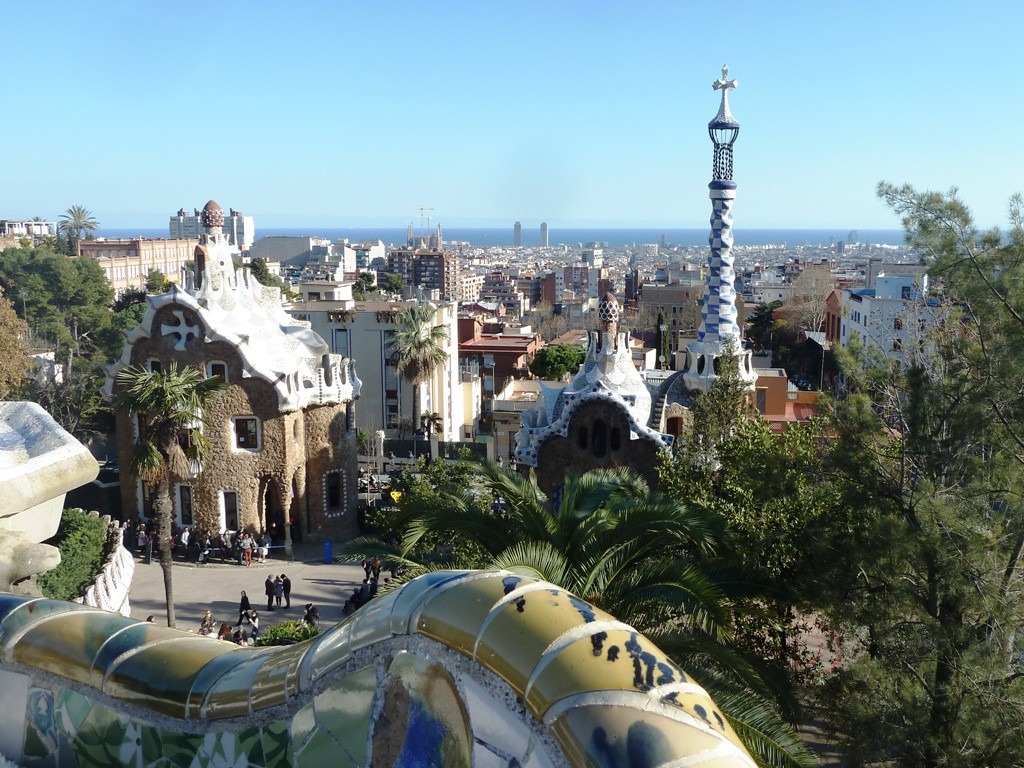
This decision has sparked a series of complaints, as in some sense the original spirit of Gaudí's creature (the park was intended to be a public space) has been partly betrayed. It must be said, though, that Park Güell, far from being a common park, is a unique landmark which must be absolutely preserved with all care.
Indeed, Park Güell consists in two main parts: the park itself, extending to a hill offering wonderful views over Barcelona and the seaside, and the so-called "monumental zone", located at the foot of the hill and on the nearby decline. This latter area includes a series of extraordinary buildings, probably the best expression of Gaudí's ingeniousness and fantasy.
While the former zone is open for everyone to visit, a ticket is needed for the second part. It will be probably a good idea, if you want to go there, to buy your ticket online (Click here for online tickets), in order to skip the likely queues at the ticket offices and avoid unpleasant surprises on the most crowded days (as the number of visitors admitted is limited).
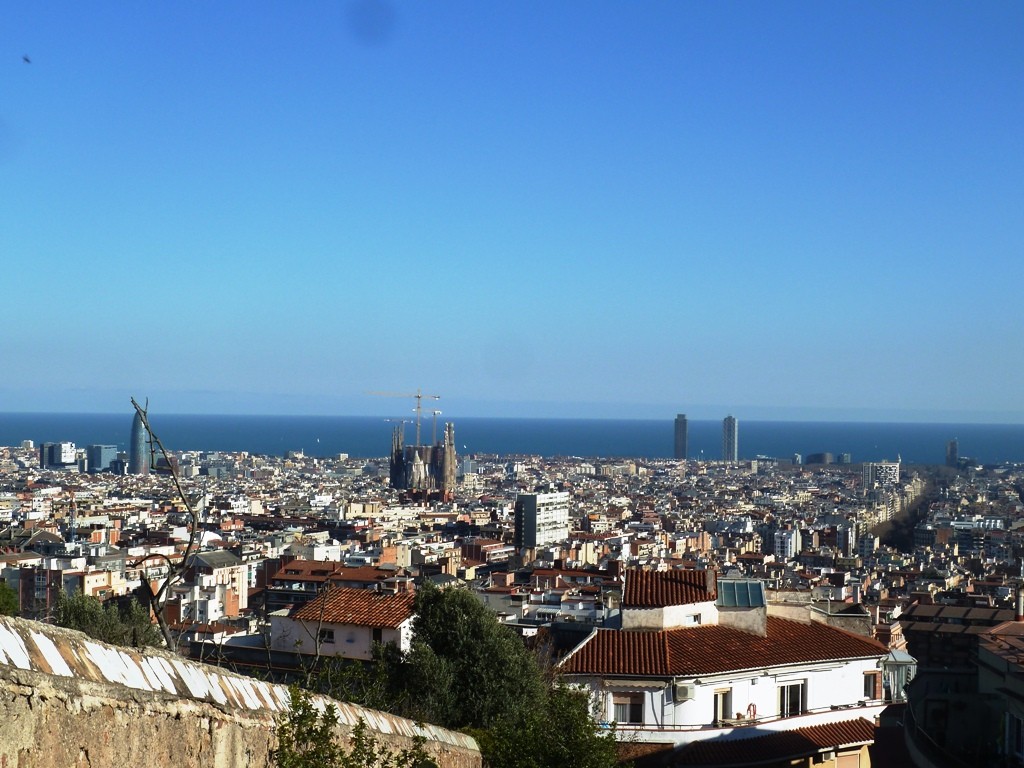
Even so, I would recommend visiting the park in the morning, when the crowd of tourists who rush in after lunch has not spoiled the unique atmosphere of the place yet. The best access to the park is probably the one of Sant Josep de la Muntanya, located within walking distance (15 minutes) from the Vallcarca station of the underground and reachable through a series of pleasant escalators which will spare you most of the climb to the hill.
Even before getting to the entrance gate of the monumental area, you will have the chance to admire a series of incredible views of the city. The unmistakable silhouette of the Torre Agbar stands out from the skyline, as well as the superb profile of the Sagrada Familia, emerging from a jungle of pinnacles and cranes. In the clear days, almost the whole city, including the blue wideness of the sea, will be offered to your sight. Having gone past the entrance, a winding sloping path, plunged into a luxuriant vegetation, will lead you to the monumental zone.
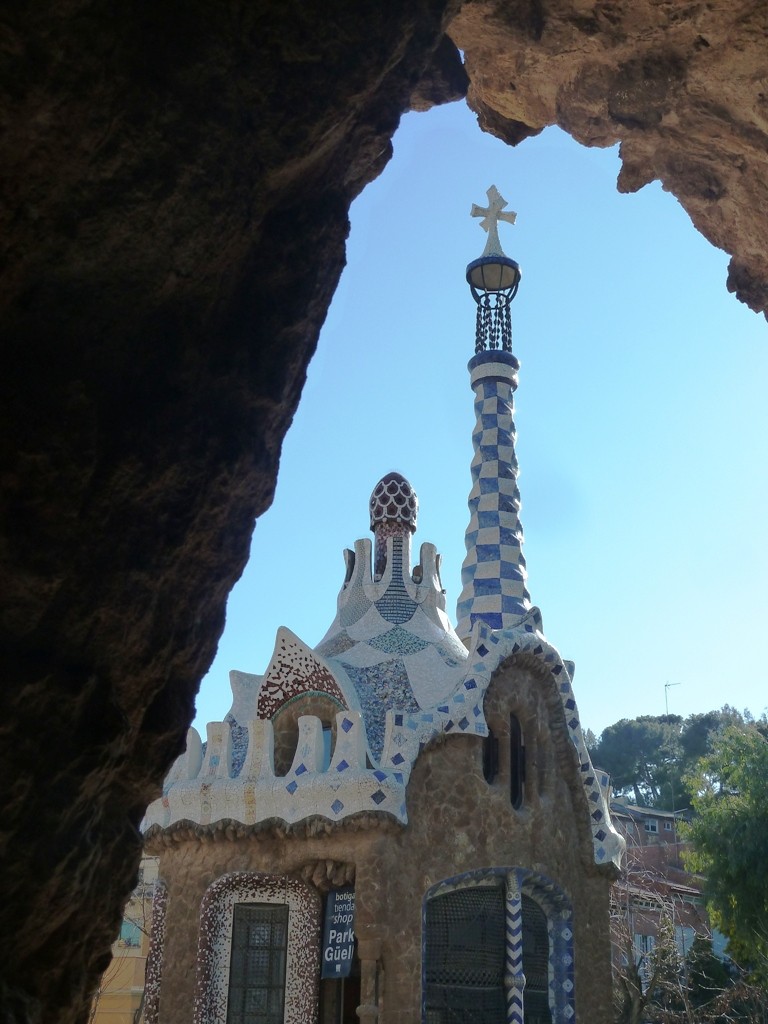
Emerging surprisingly close to the buildings of the Gracia district, you may think for a few seconds to have ended up into one of the fairy tales by the Grimm brothers. The house located in front of you, indeed, seems to have come out straight from the tale of Hansel and Gretel. It is, instead, the building which Gaudí had conceived as the reception for the visitors of the museum. Its enchanting roof is a wonderful example of trencadís, probably Gaudí's favorite decorative style, consisting in a covering of colorful pottery fragments. In many cases this material was recycled and derived from second-hand objects.
Similar features may be found in the other building flanking the main entrance to the park, namely the caretaker's dwelling. It currently houses a section of the Museu de Historia de Barcelona. Though it is possible to admire spectacular views of the two houses from the two artificial caves located in front of them, you better remember that the best is probably yet to come.
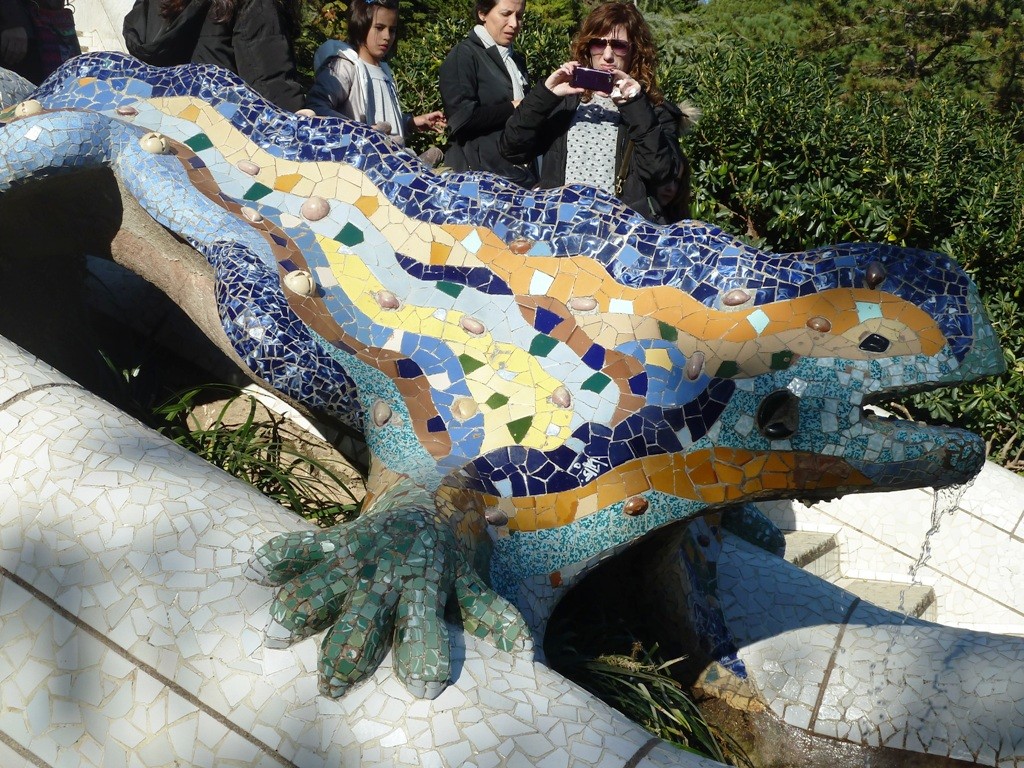
A monumental staircase, indeed, will lead you up to a landmark which appear to be a sort of Greek temple. The staircase itself, though, is worth a close look: flanked by the usual series of trencadís decorations, it includes a features a series of colorful sculptures, among which the famous salamander serving as a fountain, one of the favorite subjects for pictures (and for the realization of souvenirs). The temple, actually called Sala Hipóstila, consists in a thick forest of 86 slightly sloped columns, surmounted by a magnificent roof, composed by a series of small domes and a few superb decorations, which are the umpteenth wonder of this incredible park.
Climbing the staircase among a series of mosaics, you should probably turn around and stop for a while just before reaching the top. From the last steps, indeed, you may appreciate a superb view of the outer side of the temple and, above all, the sequence of mosaic ornaments located right above.
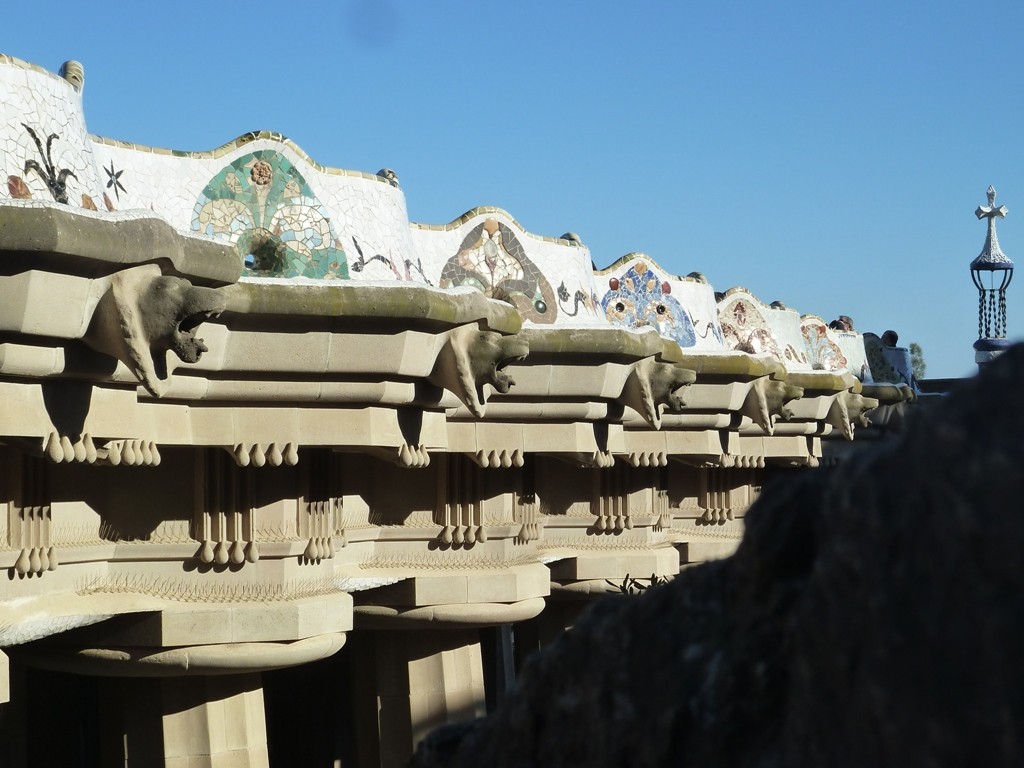
Finally reaching the upper part of the temple, you will come out into a vast clearing called Plaça de la Naturaleza. The area, which was projected by Gaudi's closest collaborator, Josep Maria Jujol, is surrounded by a colorful and unique bench characterized by the usual pottery covering.
The side overlooking the city offers a spectacular view which is doubtlessly one of the most popular landscapes of Barcelona. After leaving reluctantly this amazing area, you may make your way to the entrance through an almost equally fascinating zone, the so-called Laundress' Porch. Taking its name from an evident statue portraying a washerwoman, it consists in a spectacular colonnade whose structure is almost as elegant as it is original.
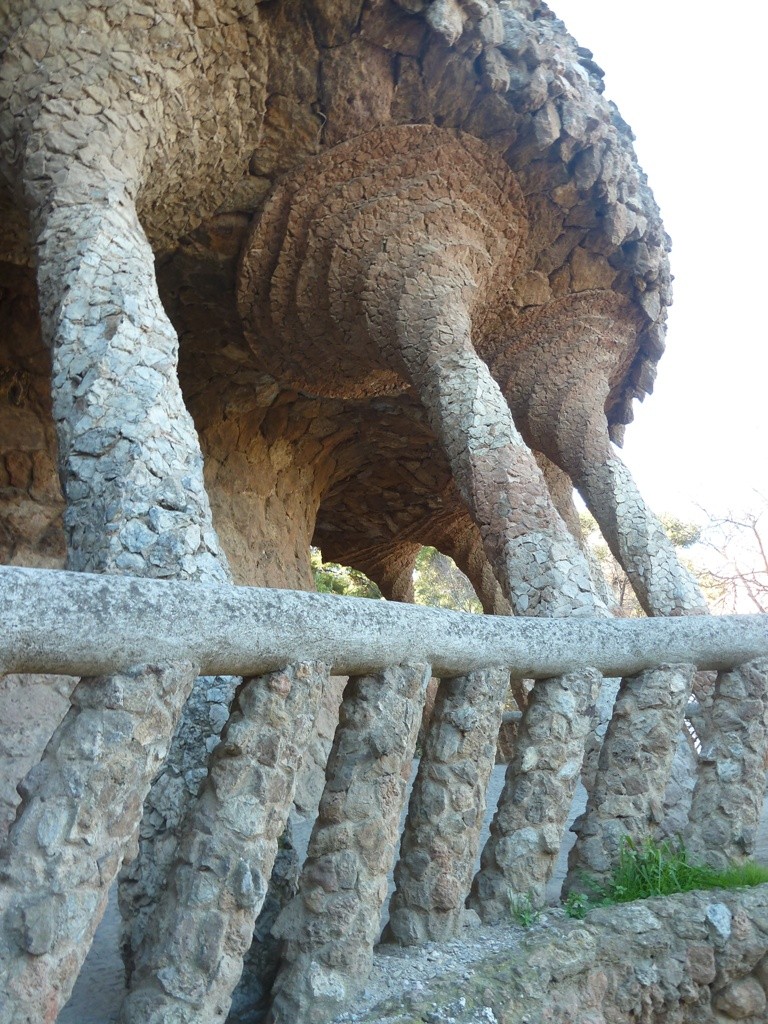
In a nutshell, Park Güell is a really unique place, probably the very essence of Gaudí and his style. Though it may be a bit out of the way (and now, unfortunately, not free any more) I think it is really worth seeing, as no trip to Barcelona would be complete without a visit to it. And you may even wonder how the park would have looked if the building works had not been left aside in 1914...at any rate, Eusebi Güell, the main patron of Gaudí, might not have had the satisfaction of seeing the original project fulfilled, but he has had his name definitely bound to a masterpiece which will be admired in the centuries to come.
Photo gallery
Content available in other languages
- Italiano: Il trionfo della fantasia
- Polski: Triumf fantasy
- Français: Le triomphe du fantastique
- Deutsch: Der Triumph der Fantasie
- Português: O triunfo da fantasia
- Español: El triunfo de la fantasía
- Nederlands: Het toppunt van fantasie
- Türkçe: Fantazi zaferi
Park or museum?
Park Güell is definitely one of the main attractions of Barcelona. Before visiting I read only positive reviews, moreover everyone seemed to be totally amazed by it. Probably this is the main reason why I felt disappointed after...
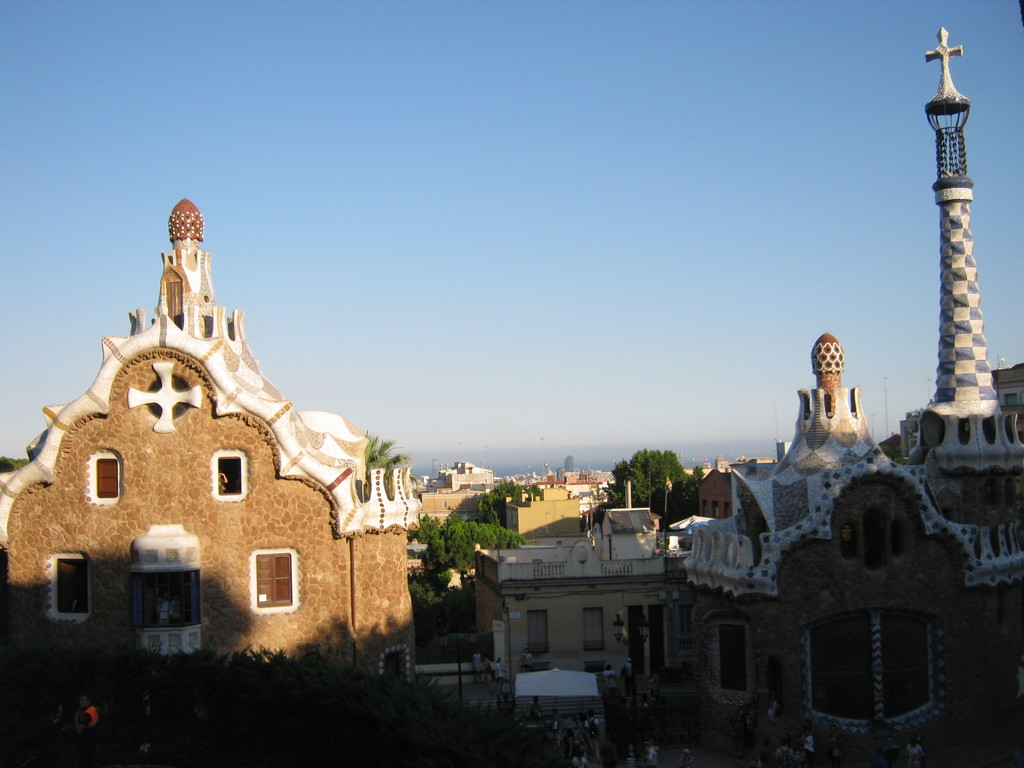
We approached it from Vallcarca metro station via the escalators. That was quite a unique experience. I mean I have never seen escalators on streets I guess!
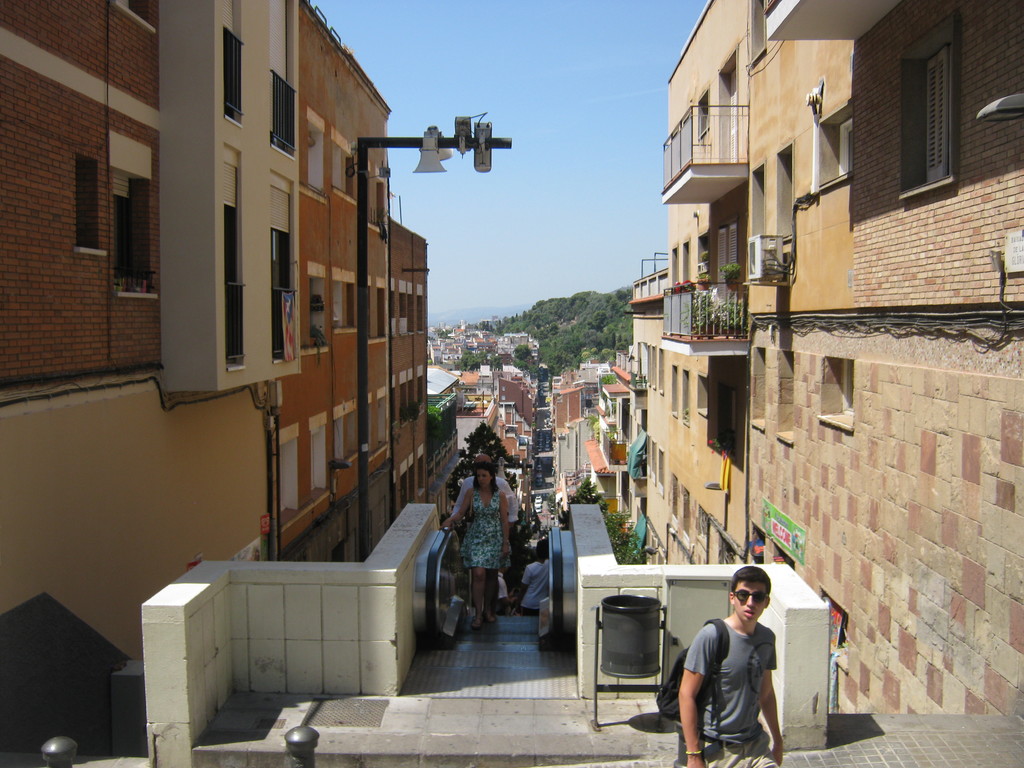
The park itself (I mean the green area where you can enter without any ticket, but you can also see already Gaudí's works and beautiful panorama of the city) would be very nice if it wasn't full of tourists... But it is. It isn't really possible to enjoy it as a park. It's better if you consider it as a pure tourist attraction, almost as a museum. If you look at it like that, you will enjoy a lot. Just don't expect something else!
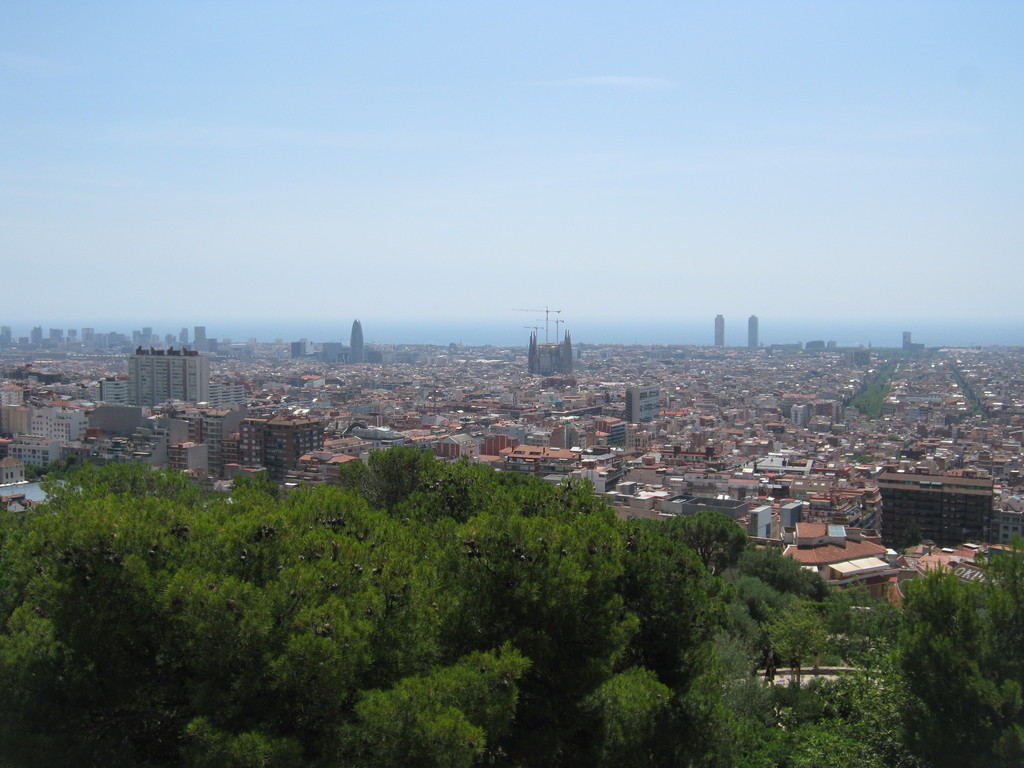

There is also the monument area, for which to access you have to buy ticket. In peak season it is not possible to buy ticket and enter directly, you can usually buy ticket only 2-3 hours in advance. This problem can be solved buying the tickets through the website and like that you can also spare 1 EUR per ticket. The price of the monument area is 7 EUR, which is for me a bit high price for a "park" that was not built to be a museum or anything like that.
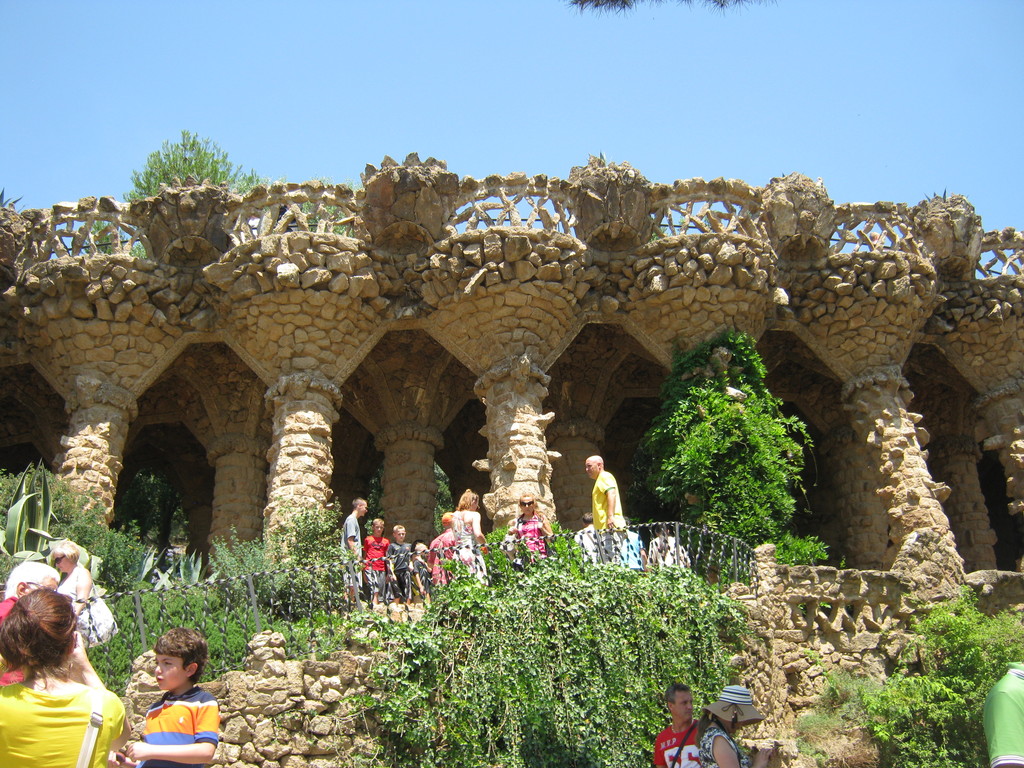
Of course if your dream has been always to see Gaudí's Chameleon, then you have to enter and you won't regret for sure. Moreover I also have to admit that the area is nice with all the works of Gaudí and I would recommend it without any doubt if it was for free, but I think if you visit the "free entrance" part of the park, it is already an experience and I would just eat a good paella for that 8 EUR after.

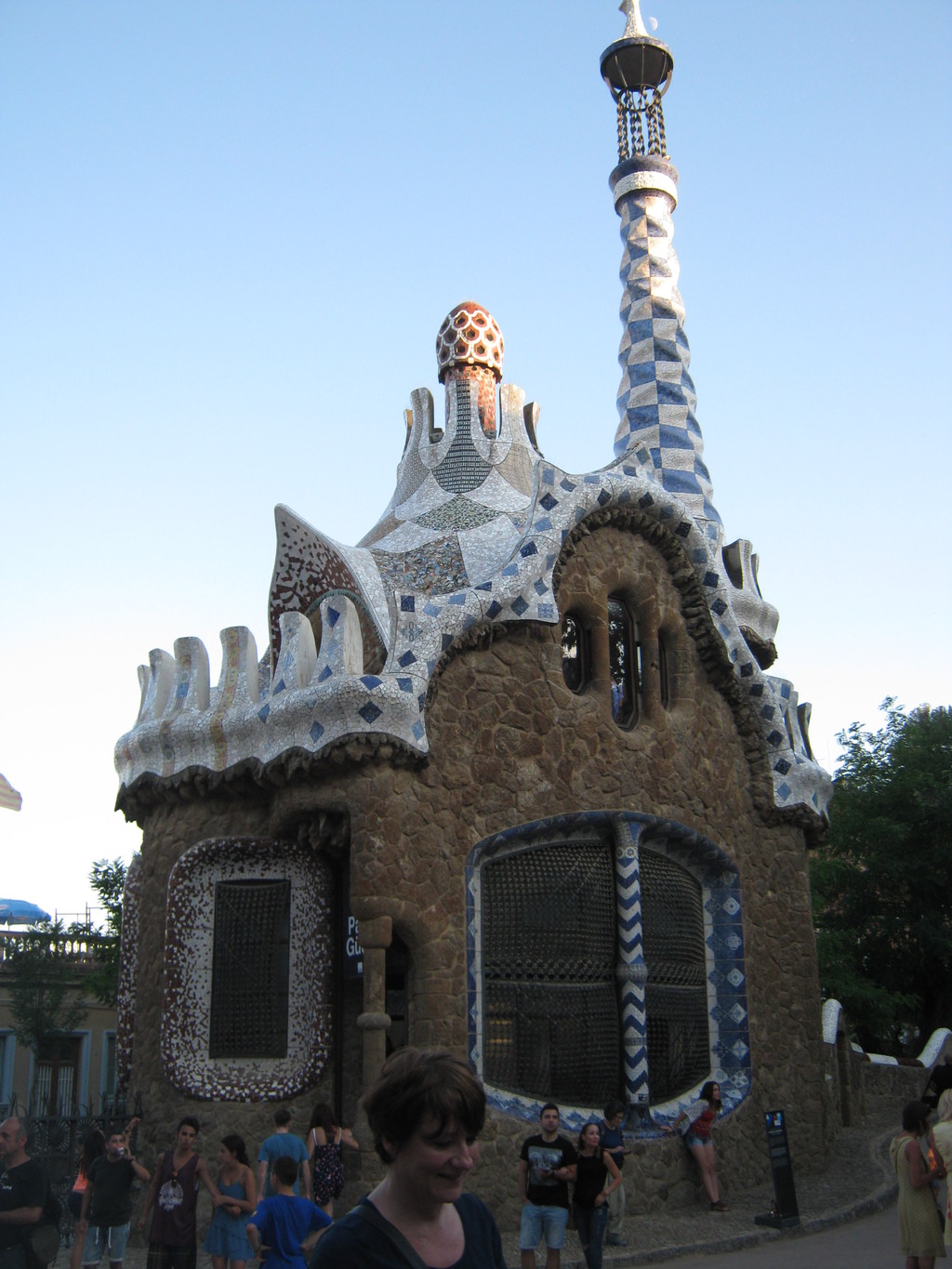
Photo gallery
Content available in other languages
- Italiano: Parco o museo?
- Français: Parc ou musée?
- Türkçe: Park mı yoksa müze mi?
- Polski: Park czy muzeum?
- Português: Parque ou Museu?
- Español: ¿Parque o museo?
- Nederlands: Park of museum?
- Deutsch: Park oder Musuem?
Parque Güell
Unquestionably, Antoni Gaudí put his mark on one of the most visited cities of Europe, Barcelona.
After visiting Sagrada Família, it is necessary to take a walk through Park Güell. I knew something about this place, but I would have never imagined that it would be two hours of stairs through this fairy tale world. Because this is how I define the beautiful Park Güell.

The Park's name is related to a wealthy entrepreneur, count Güell, who wanted to build a residential neighborhood with a garden in English style for the Catalan bourgeoisie. No neighborhood towered above what Gaudí made into the miracle of what is called Park Güell.
Built between 1900-1914, the Park is part of UNESCO since 1984 and it is a testimony of the creative ingenuousness of the famous architect. The Park area is 17, 8 ha. You can visit the park in two hours, getting an idea of Gaudí's, not seeing everything but rejoice a landscape different from any other Park.
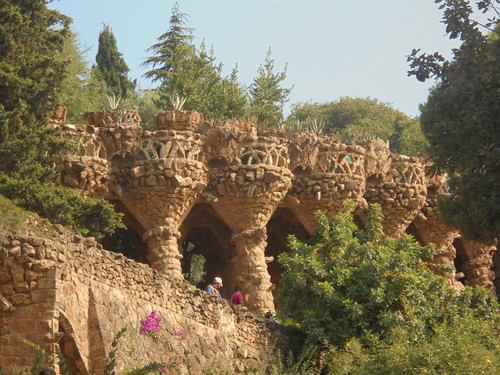
As in his other creations, Peter turned to models in nature. In the proud place, an emblem of the Park, you can see a huge salamander, made of mosaic. Moreover, this mosaic technique involves shards of pottery and earthenware called Trencadis and it is found in many other objects in the Park. Such as the bench that reflects the sunlight. If you are tired, you can rest here for a few minutes on this bench bordering a big terrace while taking some pictures and enjoying the admirable panoramic view over the city.
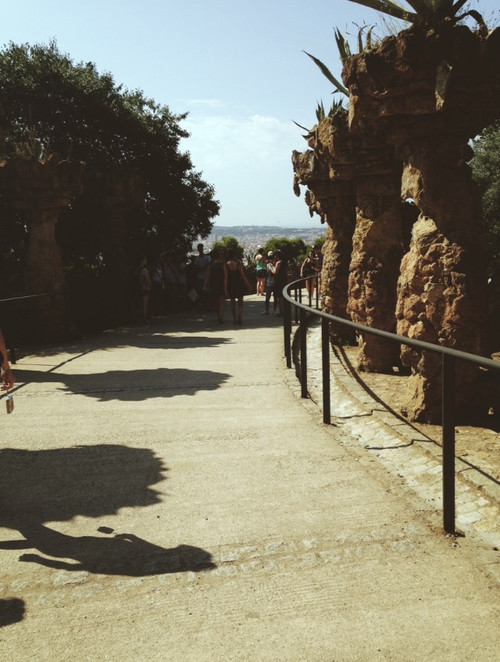
At the entrance, you see a gingerbread house and a few moments later another one, as if Hansel and Gretel were going to appear. Next, there's La Torre Rosa, the House where Antoni Gaudí lived between 1906 and 1925, it's pink like a donut. The alleys are surrounded by palm trees where parrots make their nests.
Gaudí used stones to represent the vegetation and animals. Corridors of stone of different sizes look like caves. From the ceiling hang stalactites made of stone. Stone columns suggest trunks of trees. Stone stairs take you to the top of the Park, where you can enjoy another view. This material does not, however, give a cold, lifeless impression. It is original and... fantastic, as if you are waiting to meet fairy tale characters everywhere.
The wood and stone in Park Güell is oddly shaped. Visitors come from all over the world.
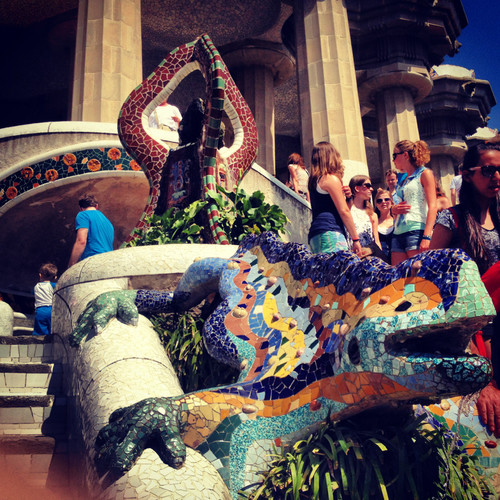
Small orchestras occur in the park, giving pleasant entertainment. I saw a band that accompanied the songs with all sorts of acrobatics. Chirping birds add to this scenery, even if you don't see them, they're hiding in the lush greenery of the palm trees.
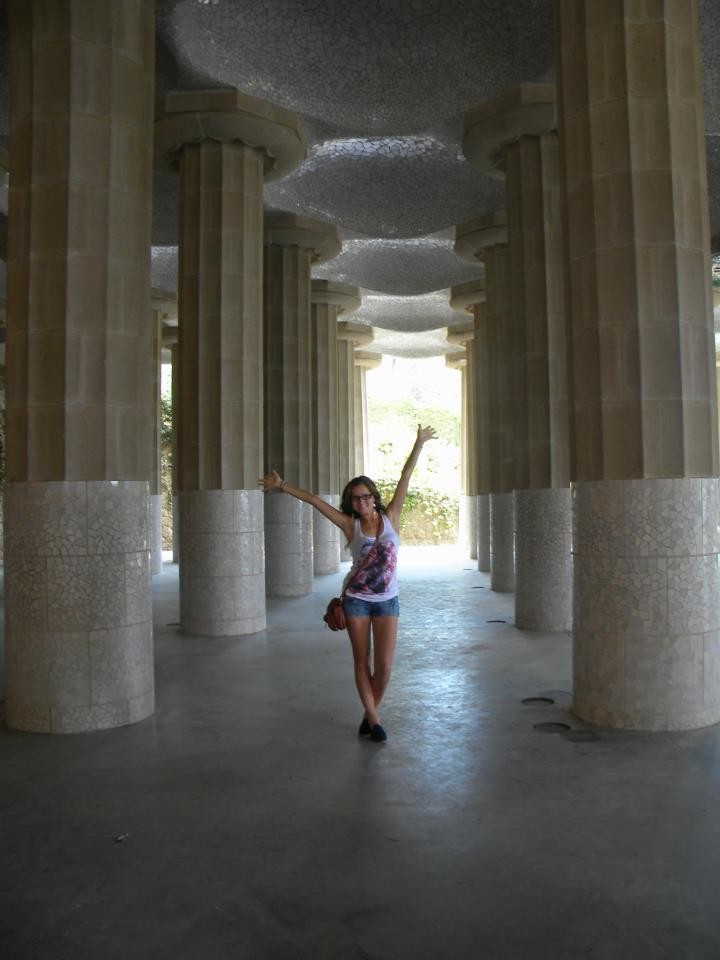
I believe that the great Gaudí wanted to re-create a magical world, drawing inspiration from nature that he used in his creative ingenious style. It came out a masterpiece.
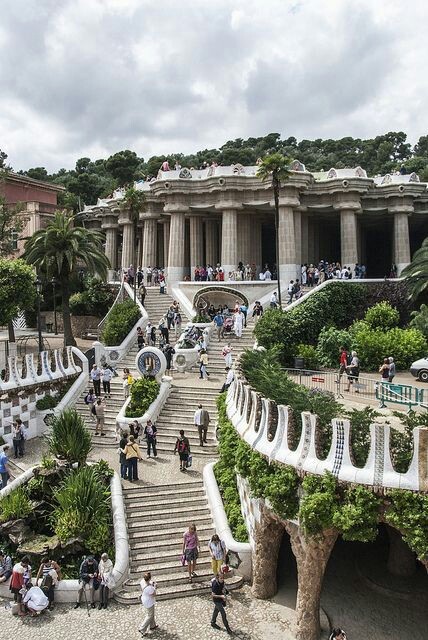
Photo gallery
Content available in other languages
- Italiano: Parco Guell
- Français: Parque Guell
- Nederlands: Betorverend Park Güell
- Português: Parque Guell
- Español: Parque Güell
- Türkçe: Park Güell
- Polski: Parque Güell
- Deutsch: Parque Güell
Park Güell
Barcelona is a lovely place to travel. You can get lost and not complain about it, get some tan on a beautiful beach, admire historical artefacts and art in galleries as well as street art downtown and if you would like to have it all, Gaudi's park offers you a perfect view on the whole city of Barcelona! Go there!
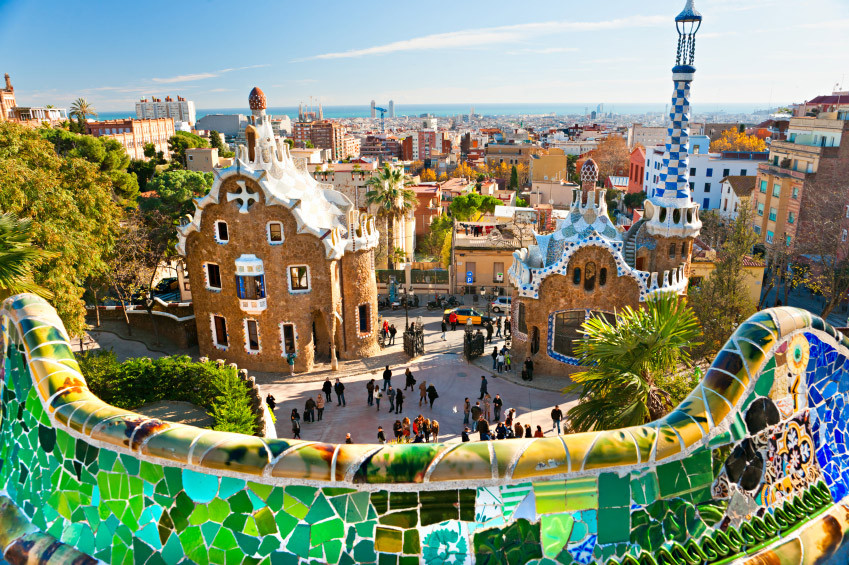
Photo gallery
Content available in other languages
- Français: Le parc Güell
- Italiano: Parco Güell
- Türkçe: Park Güell
- Nederlands: Park Güell
- Español: Park Güell
- Português: Parque Güell
- Polski: Park Güell
- Deutsch: Park Güell
Another Gaudi's masterpiece
Today I had quite an interesting day. Since I had some free time in the afternoon, I decided to visit some of the Gaudi's artworks that I have not seen yet. And I got to see three of them – Casa Batllo, La Pedrera, which is also known as Casa Mila, and a public part of the famous Park Güell. Needless to say that I was more than impressed by all of them, but, of course, Park Güell took the first place.
What is awesome about it, is that the bigger part of it is public, meaning that you do not have to pay to see it. You only have to pay to enter the Monumental zone. And I only saw the public part – I did not even go to the Monumental zone. Well, not yet! And the ticket to that exclusive zone only costs seven Euros. If you consider, what artworks you will see there, this is not expensive at all. And also keep in mind that this money goes towards keeping the park in a good state, so you are actually somehow doing a good deed by going there.
Different webpages and tourist organisations also offer guided tours around Park Güell, which cost more or less about twenty Euros. But I actually prefer to discover places by myself, rather than listen to a guide, telling me what to do and where to go.
Since I have decided to go there quite spontaneously (meaning that I just checked the location on the map and left the house), I did not purchase the ticket to the Monumental zone. After all, since it is a Spanish national holiday today, I thought that everything will be pretty crowded in there. And I was absolutely right. I mean, today was chaotic everywhere I went. I waited half an hour in the supermarket! And it was so funny for me to see people, wearing Spanish flags. So, I will probably visit the Monumental zone of the park one day this week, when less crowd is expected, and update this entry a bit.
Getting to Park Güell
From what I know, there are three possible entrances to Park Güell. I decided to take the one that seemed to be the easiest – I exited the metro at Vallcarca station (Green line L3), and then followed the signs, which lead me to Baixada de la Gloria.
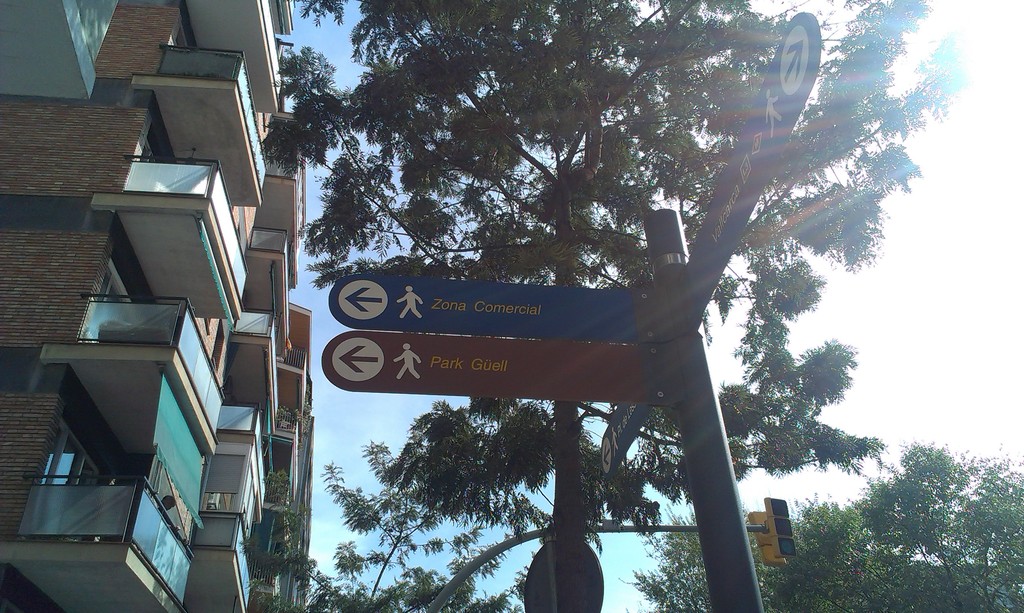
Baixada de la Gloria is a steep hill with a lot of stairs, but there are luckily also escalators at the steepest points of the hill. Seriously, how can people in Barcelona survive taking those stairs every day? I am here about three weeks now and I still hardly walk up all those hills without having to stop in the middle in order to be able to breathe!

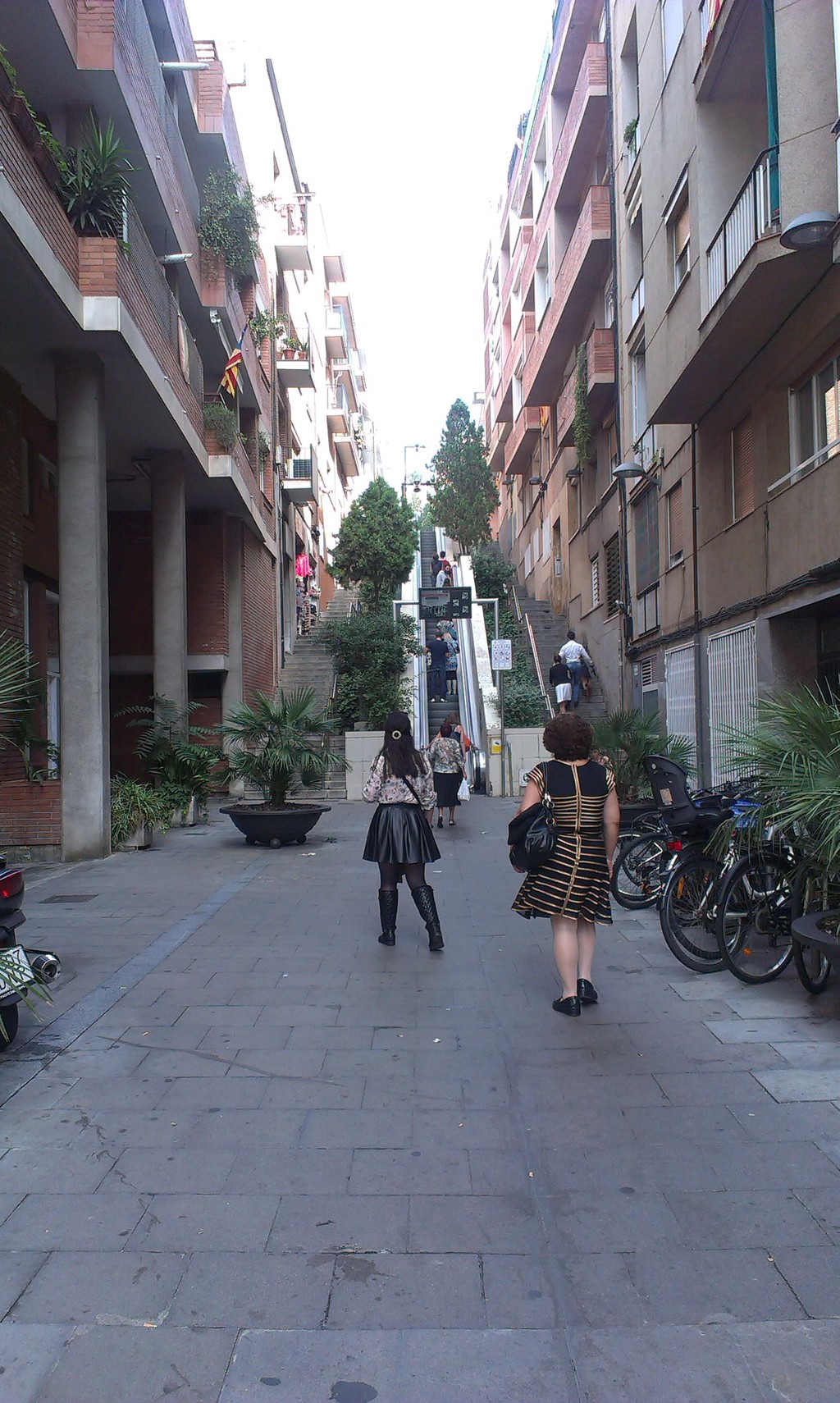
There are several small shops that sell souvenirs, and also shops where you can buy food and drinks. And next to each one of them, there is a sign that this is almost the last chance to buy something to drink. In case you did not know, you cannot buy anything to drink or eat once you enter Park Güell. But keep in mind that buying food and drinks in those shops will cost you a fortune. The best idea is to bring everything you will need in Park Güell from home.
It took me almost half an hour to get to the top - despite the escalators - and although the website stated that you should reach the entrance to the park in fifteen minutes. Yeah, right. Only if you have superpowers.
I would like to point out that the way to the park entrance is well marked. Well, I do not know about the other two entrances, but I am assuming that it should be the same there, since the park is well known.
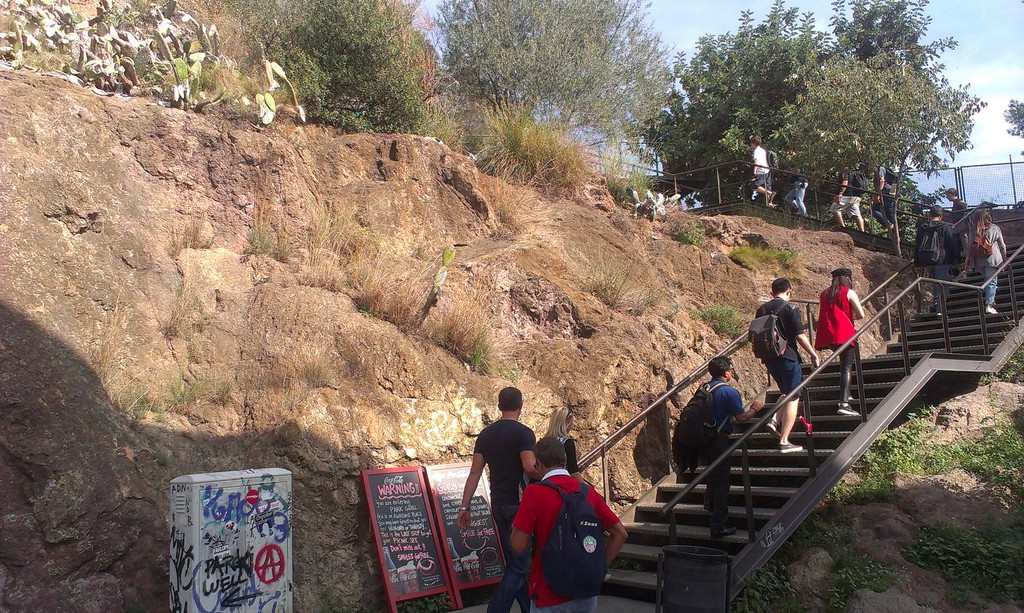
Public area of the park
When I entered the park, my first thought was: "Where are all the sights? ". Because all I saw, were some exotic–looking plants and nothing else.
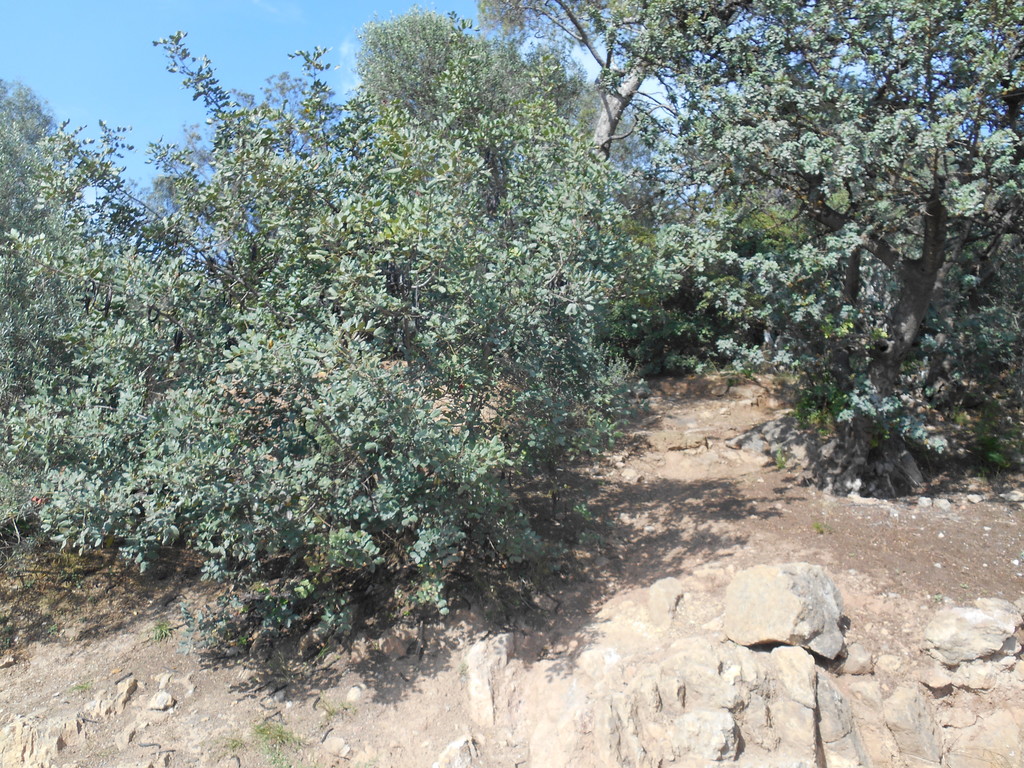
Then, when I turned on the right, I thought that this is one of the most spectacular views of Barcelona that I have witnessed so far. Yes, the view from Montjuïc hill is not nearly as good as it is from Park Güell!
I immediatelly regretted that I did not print out the park map at home. I mean, there are signs that will point you to different parts of the park, but it is still different if you have a map in your hands. At least I can orientate better this way. So I decided not to read the signs and just walk wherever I will feel to go.
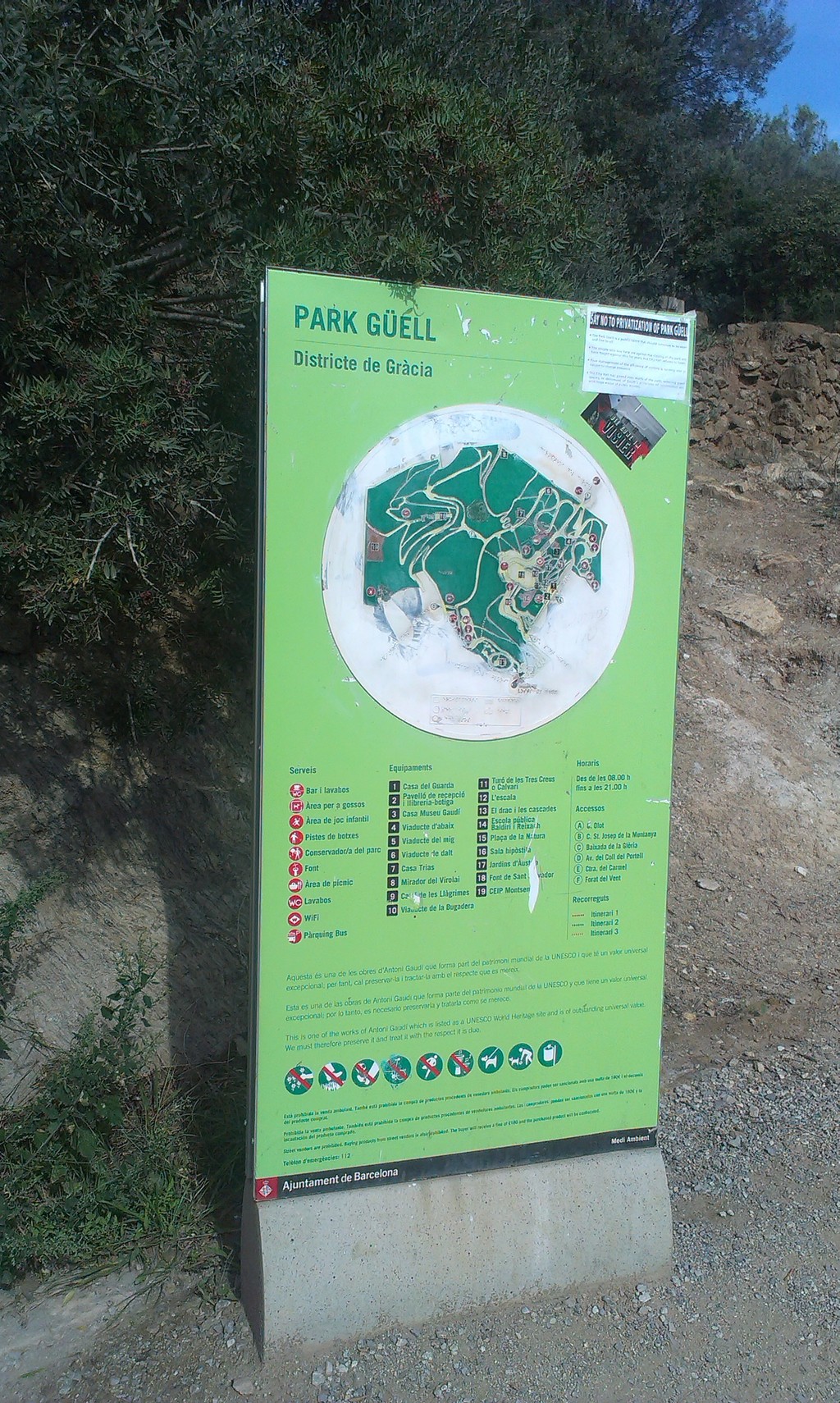
Of course, this would not be Barcelona if there were no hills, so I had to walk upwards for some time. But at least this part was not very steep, so I was able to get to the top without having to stop in the middle of the way up.
At the top, the views were even better. And I was surprised that the trees were not covering the best parts of the view. Also, I was amazed how many buildings I was able to recognize in the city. I almost felt like a local for a few seconds!
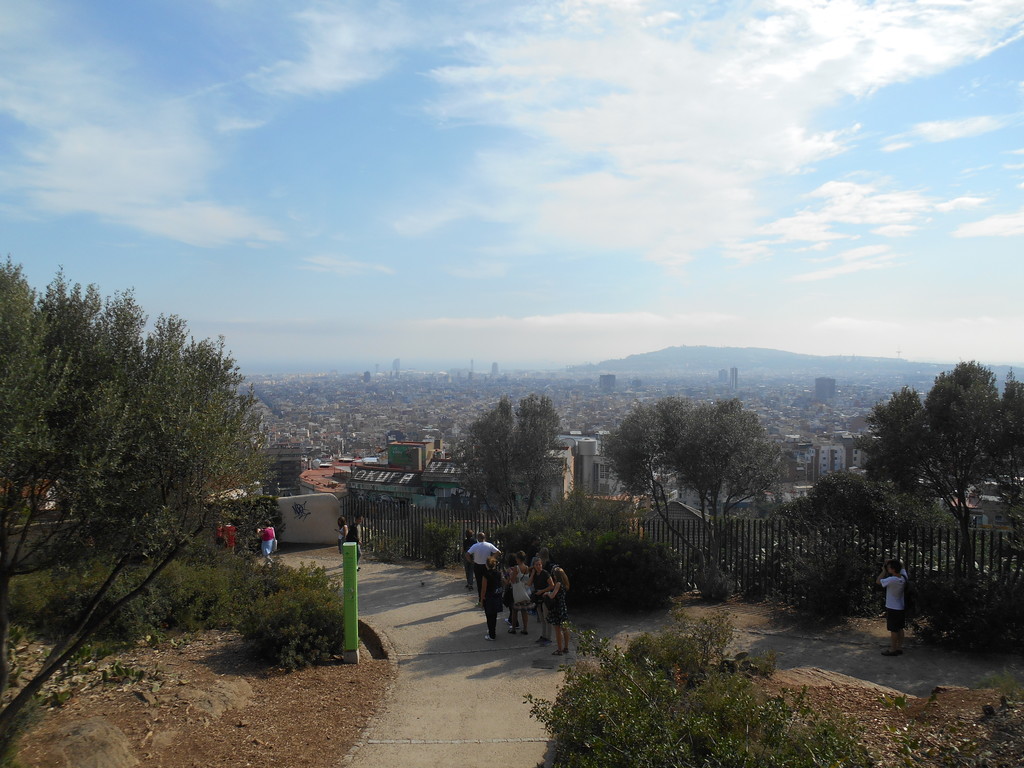
Then, I continued my exploration of this awesome place. This time, I have chosen the path that leaded downwards, so my legs could rest a little bit. After a few hundred meters, I have reached the picnic area, where some people were celebrating birthday. And there was a gate, which seemed like another entrance to the park. From this point, I was able to clearly see the Tibidabo mountain and I was amazed how close it seemed from where I was standing.
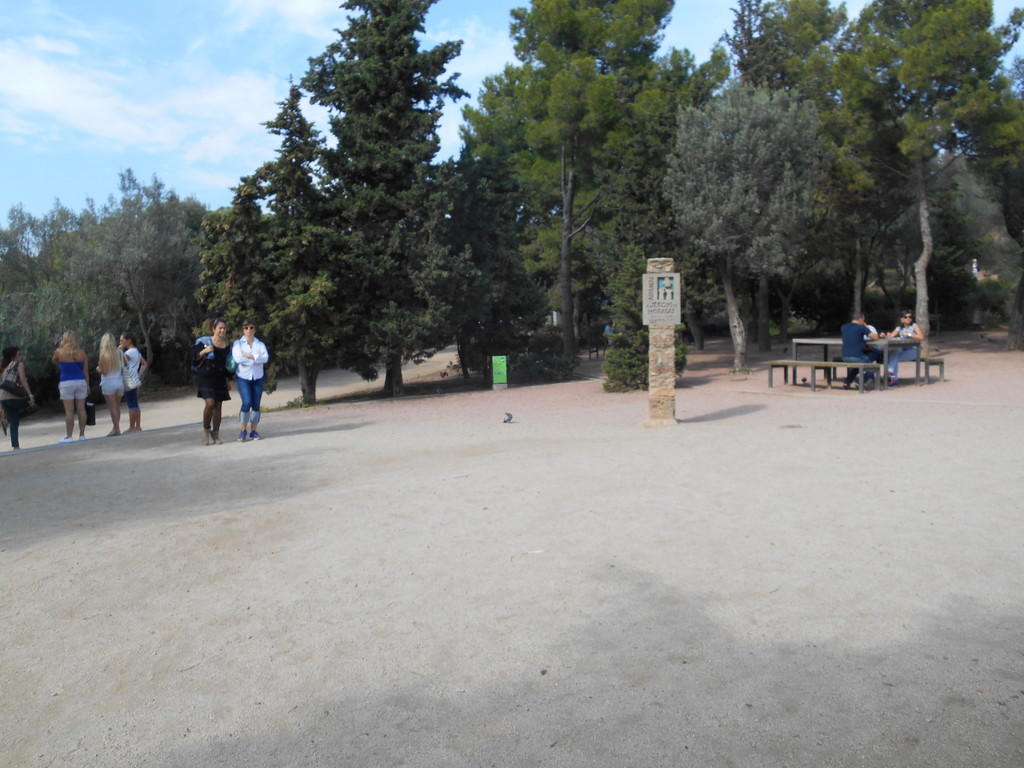
There were also two musicians, one was playing violin and one was playing the drums. And I have seen another one just after the entrance. I must say that there is a lot of great street musicians here in Barcelona, and I always feel bad when I have not time to listen to their performance for a longer time than I can.
Since there was a little clearing on the right side of that picnic area, I decided to go closer and take a look what is there. I was very surprised when I saw that there is actually the Monumental zone! I did not even plan to go that far, but since it seemed only a few hundred meters away, I decided to take a look and check how far can I get. After all, before going to Park Güell, I imagined that the Monumental zone is situated like an hour away from the park entrance. And I am so glad I was wrong!
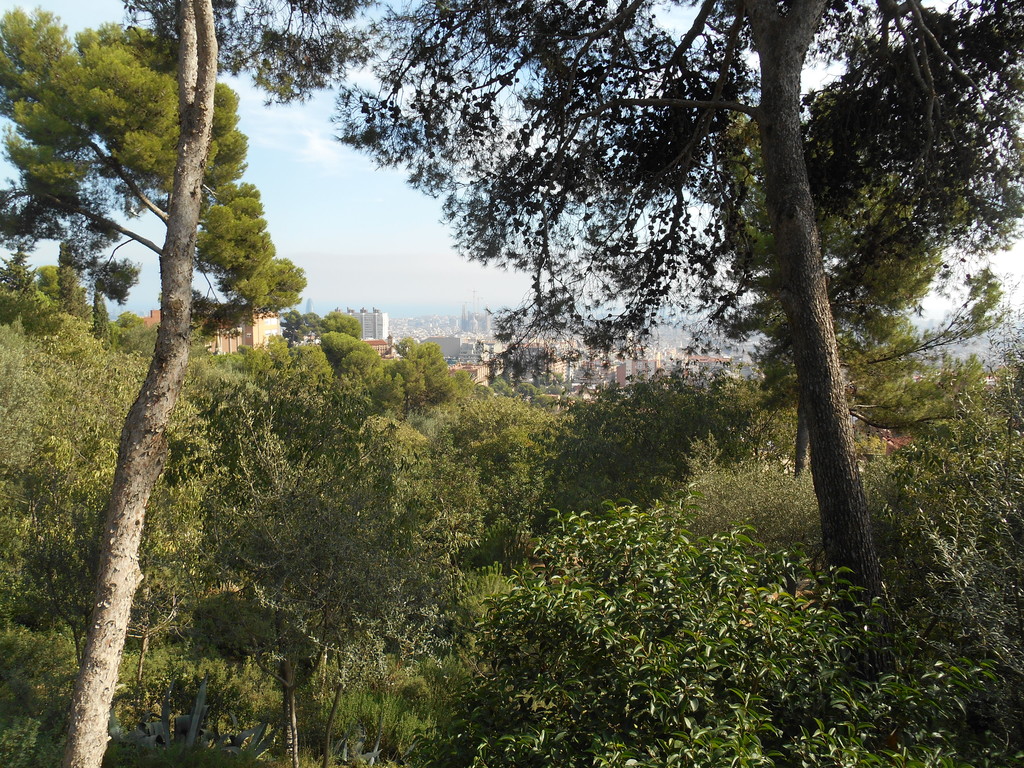
The path there was almost straight, which made me very happy for a few minutes, but then I saw another hill. Luckily, it was not too steep, and at the top, I was rewarded with a spectacular view of the Monumental zone below me and the city of Barcelona behind it. I had to stop for a few minutes to admire the view. Actually, I was probably standing there more than fifteen minutes, but I did not care.
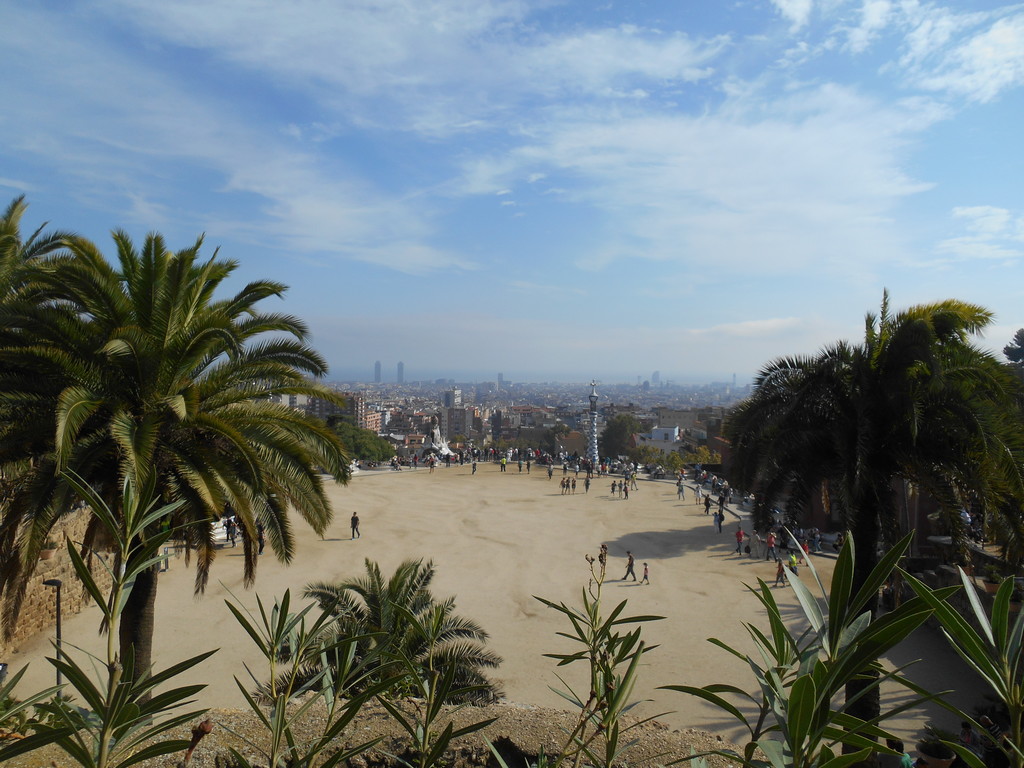
And there was a thing that started to annoy me, so I have decided to move on. Inside the park, you will see a lot of people, selling bottles of water for one Euro, and shouting that out, like everybody needs to know it. So, there was a guy, and each time he passed by me (I stopped counting how many times it happened after a while), he acted like he saw me for the first time, approached me and shouted: "Water, one Euro! " Like I did not hear him for the first time. Besides, if I wanted to buy water, I would have approached him, and since he was quite loud, it was obvious that I had heard him.
So, as I said, I then moved on. A few meters ahead, I have noticed some stairs on the right side, which I thought should lead down to the monumental zone. And I was right. I was also impressed, how much you are actually able to see from there. Well, I am sure that it is much different if you are really standing in the heart of the monumental zone, but even being above it completely satisfied my standards for today.


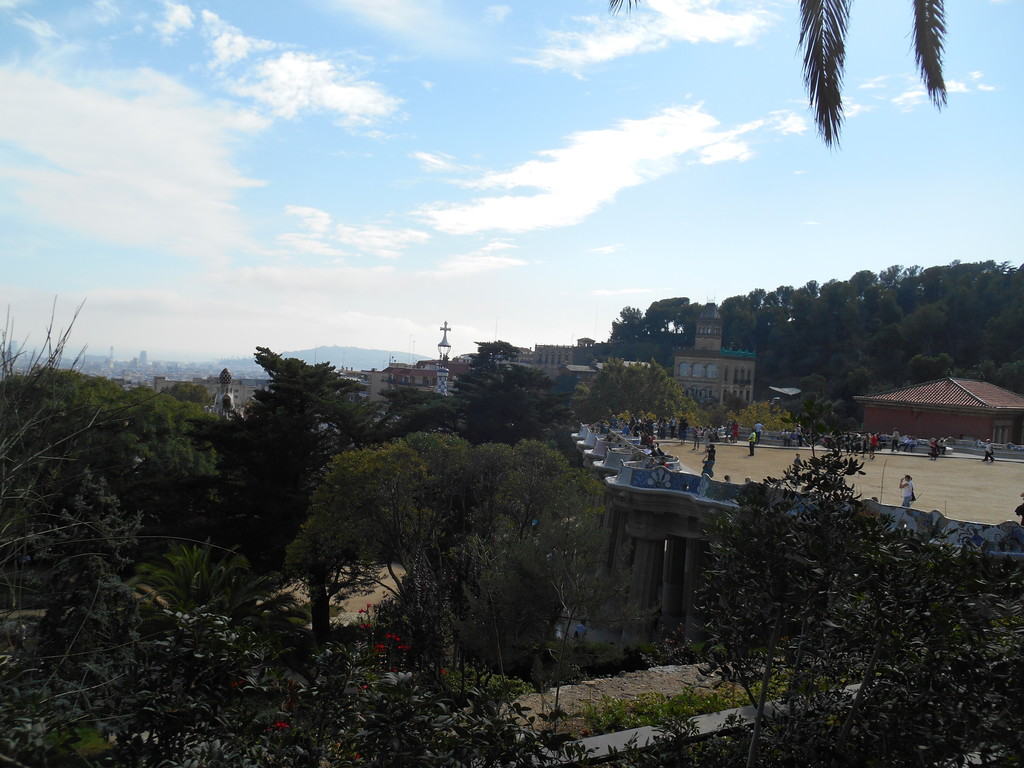
The queues of people, waiting to get to the monumental zone, were not as long as I expected, but still long enough that I did not feel like waiting. After all, they could say that I cannot buy a ticket there, and I would waste time for nothing. And in case you were wondering if it is actually possible to sneak inside without paying that seven Euros, let me tell you that if you want to do it, you will need an invisibility cloak. There are a lot of staff members at each point of the entrance, and you have to have a ticket with you.
So, after wandering around a little while, I have decided to go back. At first, I was worried that I would not be able to find the way back, but it turned out that it is actually pretty easy. I was really scared that I will end up at another side of the park and I will not be able to get out of the park before dark. But luckily I did. And I also survived those damn stairs without any bigger damage. Well, when I am writing this, my thighs still hurt, but it was totally worth it!
An artistic conclusion
As you can imagine, I have read several articles about Park Güell before going there; and I must say that the composition of the park is much different than I have imagined. But in a good way, of course. Most people in Barcelona say that the Park Güell should be considered as a museum, and I totally agree with them! Have I mentioned that Gaudi was an absolute genius? Well, now you know it. But you should still see Park Güell for yourself, just to make sure that I am not lying.
Photo gallery
Content available in other languages
- Français: Un autre chef-d'oeuvre de Gaudi
- Italiano: Un'altra opera di Gaudi
- Polski: Kolejne dzieło Gaudiego
- Español: Otra obra maestra de Gaudí
- Português: Outra obra-prima de Gaudí
- Türkçe: Gaudi'nin Diğer Başyapıtı
- Nederlands: Een ander meesterwerk van Gaudi
- Deutsch: Ein weiteres Meisterstück von Gaudi
A true insider's tip on the best way to enjoy the Park Güell

The Park Güell is probably one of the most famous sights of Barcelona. . It is one of the masterpieces of Antonío Gaudi, who has left his traces in many parts of the city. The park, which is situated on the Carmel Hill in the district of Gràcia, was built between 1900 and 1912 and is declared a UNESCO World Heritage Site. Park Güell is known to be one of the most crowded tourist attractions and today I want to tell you about a special way to enjoy the park in a different way than normal tourists do.
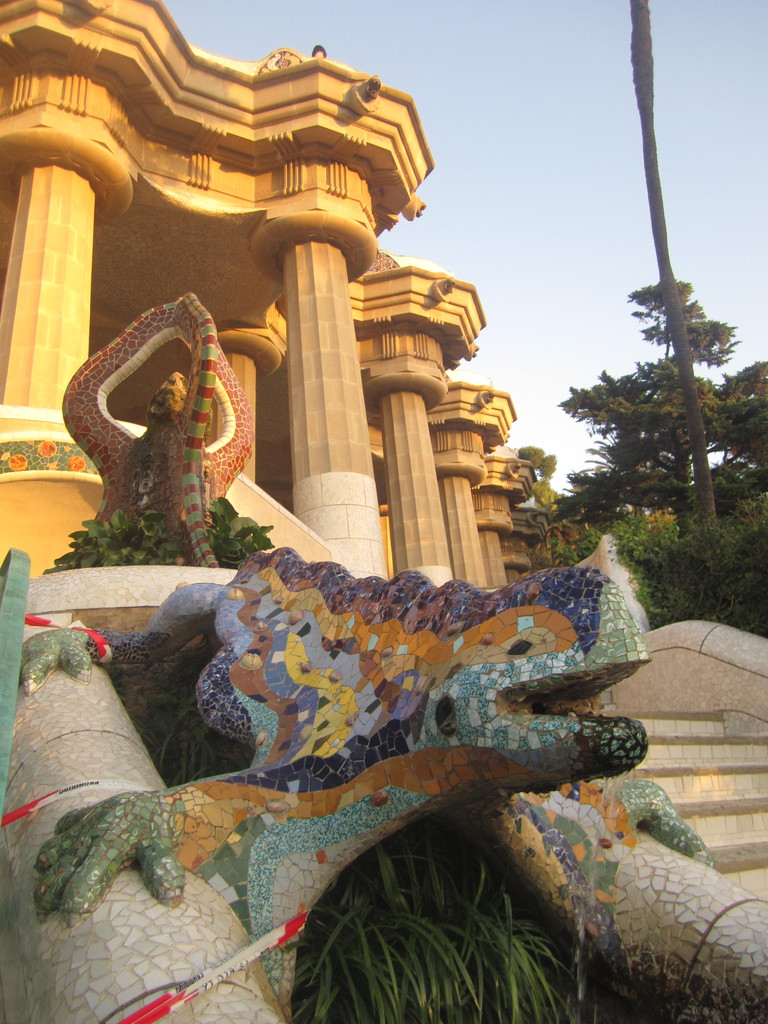
To me the park is a great mixture of a natural park and the special architecture of the legendary Gaudi. Especially in the back the park is just a “normal natural park”, with trees, flowers and little stone ways leading through the park. At the entrance you can already directly dive into Gaudi's Art; the two buildings in the typical Gaudi style give a foretaste to what is to expect behind the entrance.
The park consists of a lot of incredible and colorful stonework of Gaudi. Right at the beginning you find one of his masterpieces: the Salamander Fountain. It is made of mosaic in different colours and is a popular photo motive for tourists. Over the salamander, next to another beautiful mosaic, you find a fascinating building with high pillars.
On the roof of this open building is the highest part of the park located. It is a big terraced area which is my personal highlight of the Park Güell. The square of the terrace is pretty big and characterized by the famous mosaic bench, inviting you to sit down and enjoy the incredible view on the park and the city of Barcelona. Next to numerous other arches, walls and statues of Gaudi, there is also a little house, where Gaudi himself actually lived for a while and which can be visited as well.
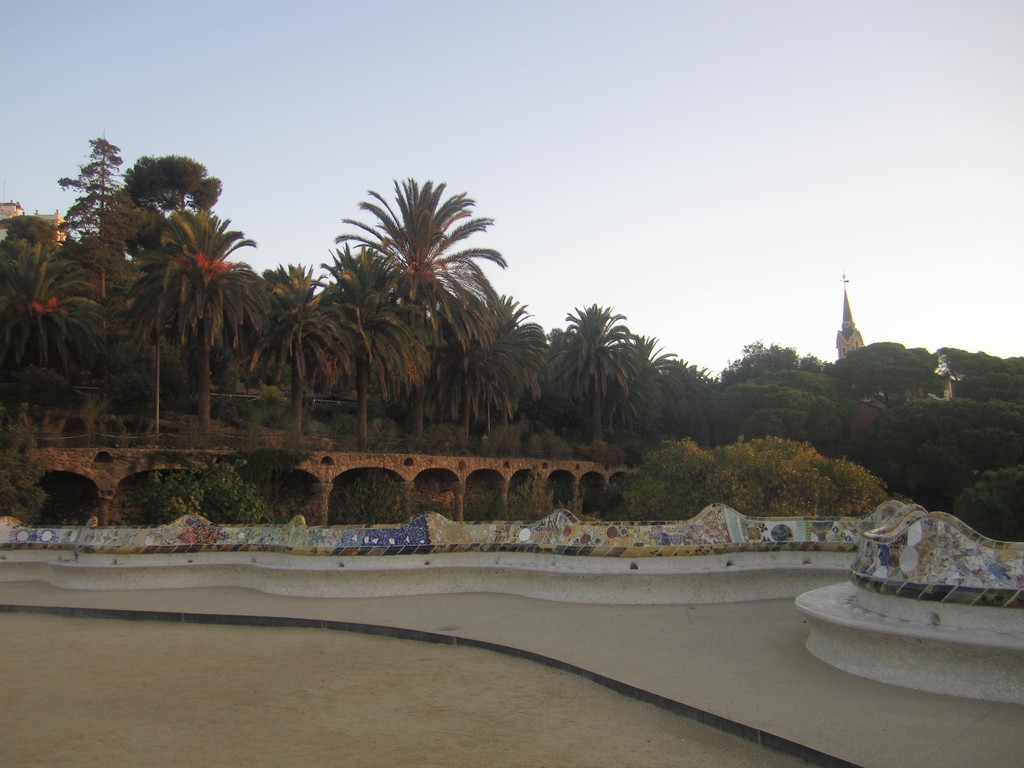
The downside of Park Güell is definitely the mass of tourists you find here every day. If you want to visit the park during a regular afternoon and didn’t make any reservations, you have to deal with a waiting time of sometimes up to several hours, as they just let a certain amount of people onto the square. The admission to get onto the terrace is 7€, which is in my opinion pretty expensive just to enter the terrace, as you can be sure to have to share the bench with dozens of other tourists, each trying to get a good picture of the bench and the city.
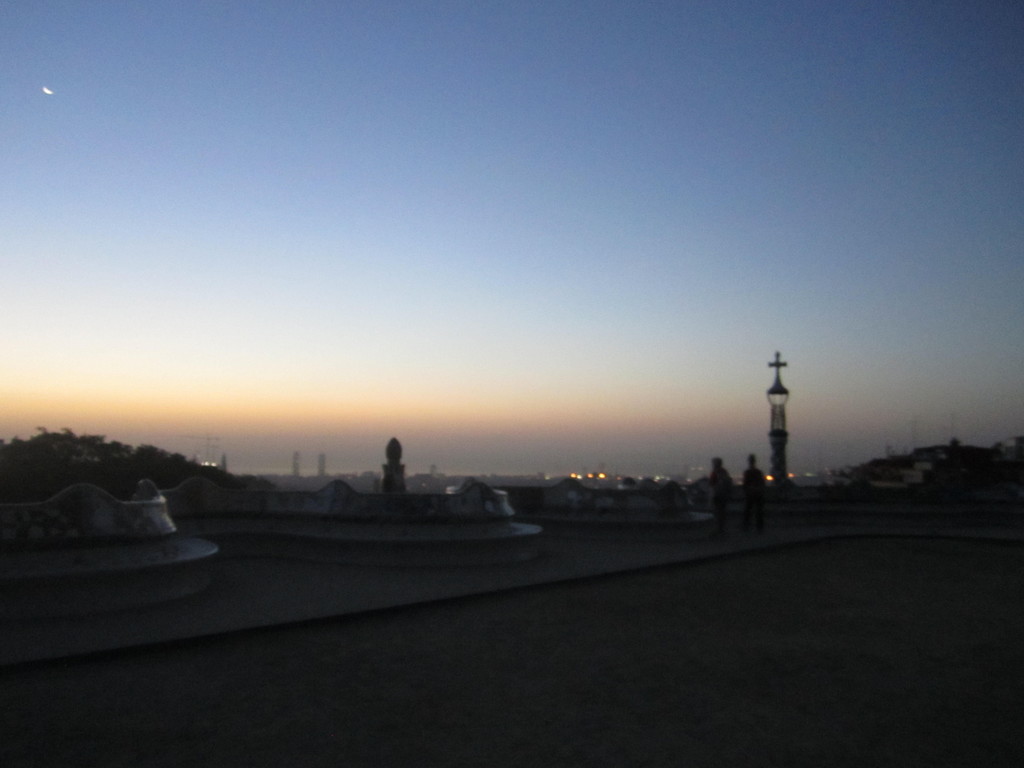
I did something different when I visited the Park Güell, something which is a true insider’s tip and a way to enjoy this beautiful place in a much nicer way than probably 99% of the people do. I went in the early morning in October, before the sun rose. Because before 8 o’clock, when the park is not officially open yet, you can already get inside (we took the back entrance) and you don’t have to pay a single cent of entrance fee.
Two other big benefits you get from waking up really early and making your way up to the hill in the dark are first of all that you have the whole park pretty much to yourself, and second, you get to see an incredible sunrise! When we were there, there were really just me and my two friends and maybe two or three other people, who also got up to take pictures of the sunrise over the city.
It really is a strange view, when you see the big terrace completely empty, a sight you could never get during daytime at any day of the year and you probably have never even seen on pictures. Then the sun starts rising, offering us the most beautiful start in the day in Barcelona. It really was the most scenery view: the park, the skyline of the city, the sea in the background and the sun rising over it. So we were there sitting all by ourselves on the bench of Gaudi, eating our breakfast, looking down on the Park Güell and the city of Barcelona- a priceless moment!
I really don’t remember a nicer morning I had in Barcelona! When the sun was half up on the sky, slowly the first tourists were entering the terrace square and we had time to enjoy the rest of the park in peace.
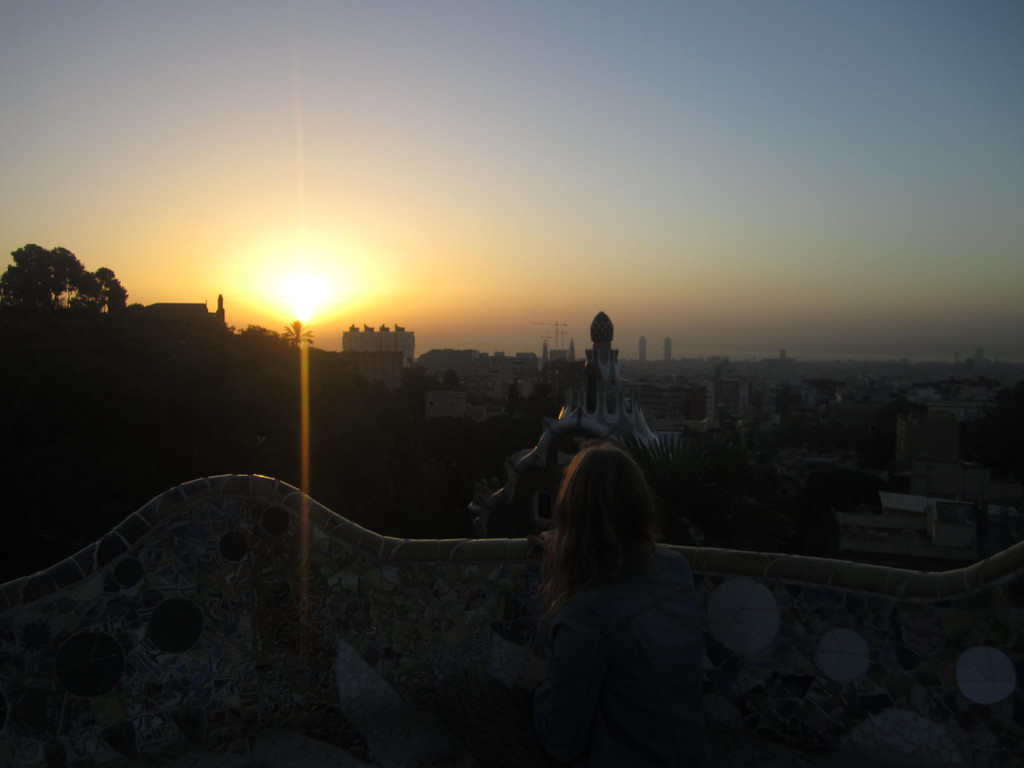
To me this park has an incredible beauty with so many details and so much colour, especially the wave-like bench on the terrace is a true masterpiece of art - and if it would be always as empty as in the morning, I would probably have been there every day! But the dozens of tourists definitely have kept me from visiting it more often.
But either way, if you are for the first time in Barcelona, you should visit the Park Güell. And if you have the motivation to get up early in the morning, I strongly suggest you to do so, because this really is a whole different experience to be there all alone in quiet and peace. And additionally it is an unforgettable sunrise you get to see from Barcelona’s most beautiful bench.

Photo gallery
Content available in other languages
- Français: Comment profiter de votre visite au Parc Güell: les conseils
- Türkçe: En keyifli Park Güell gezisi için tecrübeye dayanan tavsiyeler :
- Italiano: Come godersi al meglio Parco Güell: consigli di un vero insider.
- Español: Consejos de un verdadero local para disfrutar del Parc Güell al máximo
- Português: Parque Güell: Como ter uma experiência única
- Polski: Wskazówki dla wtajemniczonych na dobrą zabawę w Parku Güell
- Deutsch: Tipps von einem echten Insider wie man den Park Güell am besten genießen kann
- Nederlands: Echt advies van een insider om het meeste plezier aan het Park Güell te beleven
Park Güell
After returning to Barcelona once again, today I'll be talking about another one of the most attractive tourist sites of the city, one that you will have almost definitely already heard of... Park Güell!

Continuing our tour of Barcelona, one of the sites that we couldn't miss out on was Park Güell. Trekking up all the stairs would be worth it just to get a photo of us sat on the mosaic seating, and of course to enjoy the view Barcelona had to offer. We went after we'd already wandered around and gotten to know the city so that when we climbed high up, we could try and spot the neighbourhoods and monuments we'd already visited.
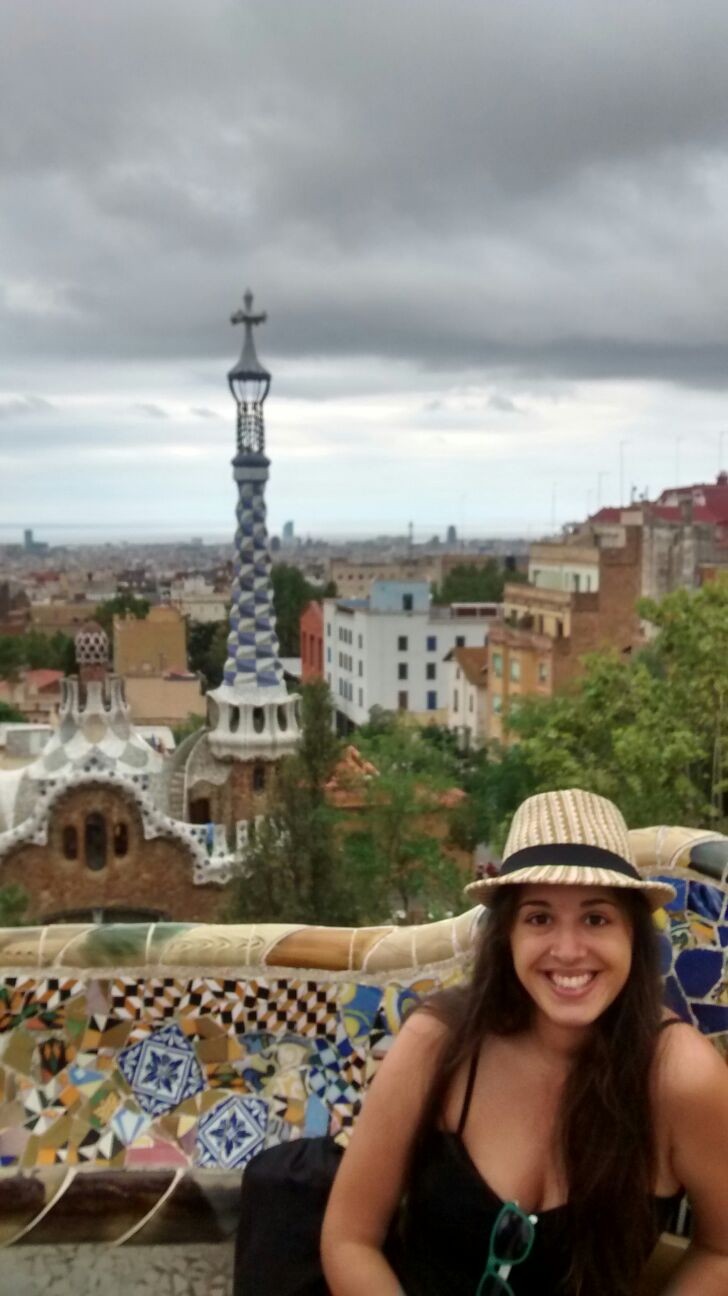
The park consists of an area of more than 17 hectares (170, 000 metres²), with big green spaces and gardens that go round this great architectural work of Gaudí. It doesn't take very long to see the main central part of the Park so to really get the most out of it I'd suggest taking a good long walk or having a tour around the Park, and climbing up to its highest points.
Different to what we originally thought, the entrance to the park is not free; from October 2013 visitors have to buy tickets to enter the centre where all the monuments are. This includes the central square with the mosaic seats, the school, Gaudí's house, and being able to see the pavilion at the entrance and the stairway. However, you can access the rest of the park for free. I think that the decision to start charging an entrance fee was made because it was too overcrowded with tourists and since introducing the charge, the number of tourists has dropped from 9 million to 2. 5 million a year.
Gaudí based a lot of his work on finding natural ways to build things such as the benches, columns, and viaducts you can find in the park. Personally, I enjoyed visiting the gardens more than the architectural centre; getting to the top and seeing the scenic view of Barcelona was amazing, even despite the weather not being its best (it wasn't very hot and there was a storm coming). There's no denying that it's beautiful, and by all means absolutely anybody, even without any prior knowledge in architecture, can appreciate the gorgeous shapes and the way Gaudí skilfully integrates nature into his work. However, for me, the Park doesn't go beyond superficial beauty.
History
The construction of the park lasted from 1900 until 1914, before finally opening as a public park in 1926, although originally it was designed to be an estate for the well-off. Eusebi Güell, whom the park is named after, was the entrepreneur who commissioned and handed over the architectural work to Antoni Guadí; a Catalan Modernist at the time. As I mentioned in my article on the Sagrada Familia, Park Güell was also declared a World Heritage site by UNESCO in 1984.
Structure
At the park entrance where you buy your tickets, you are also given really useful leaflets which explain the park's history and provide a brief insight to the architectural structure. The pamphlet is a good way of not getting lost as it explains where you should go and in what order too (the natural order of the spots you'd visit changed since the development of the ticket office at the entrance in 2013). Also, the booklets provide recommended routes that you can take that mean you get to see all of the interesting sites like Sant Josep de la Muntanya, Calle de Olot or Plaza de la Naturaleza.
At the lowest point of the park there is a beautiful 'entrance' with two pavilions next to each other, but watch out, as it's permanently closed. I think that it has to stay closed now in order to keep the Monument Precinct, which people now have to pay to see, more private. The entrance to go inside is now at one of the highest points of the park, right next to the ticket office.

The pavilions are very interestingly shaped and have multi-coloured roofs that kind of remind me of a fairytale. The smallest one is used for administration and as a gift shop whereas the largest one is actually used as a lobby.
Then, as you go through the lobby and enter the park, you'll see a twin flight of stairs, amongst which you'll come across the famous dragon, aka The Salamander Dragon, decorated with colourful mosaic tiles which has become iconic to the park. They say that when you walk past it you should touch it for good luck.
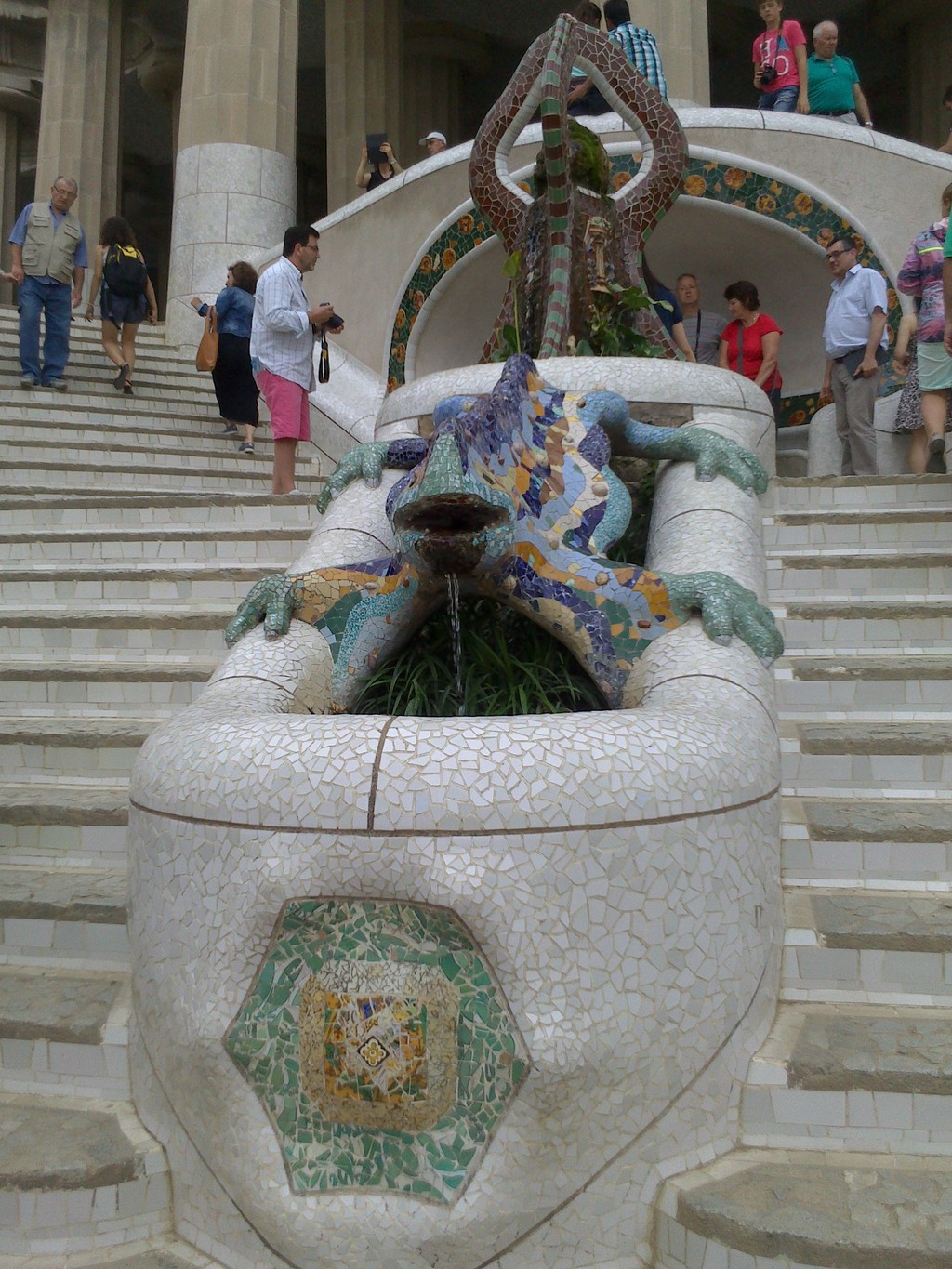
On the flight of stairs just before the dragon, is a bench which is inside a wall, a bit like a cave. It was made so that in winter you are in the sun, and during summer you are shaded. You can see it in the photo of the dragon (the outside is decorated with green and yellow mosaic tiles). It is also a beautiful spot for visitors to take photos of the panoramic view of the park entrance.
If you carry on going down the stairs, you'll wind up at the Central Plaza which took 6 years to build (1907-1913) and at first was supposed to be a residential area designed for all the residents to go to as a place for holding religious and cultural events.

This 3000m² oval plaza is where you can find the famous undulating benches that are predominately decorated with yellow, green, and blue mosaic tiles and window panes (like in my second photo). It is Barcelona's favourite lookout point as even with bad weather, like when I visited, you can still see the whole city.
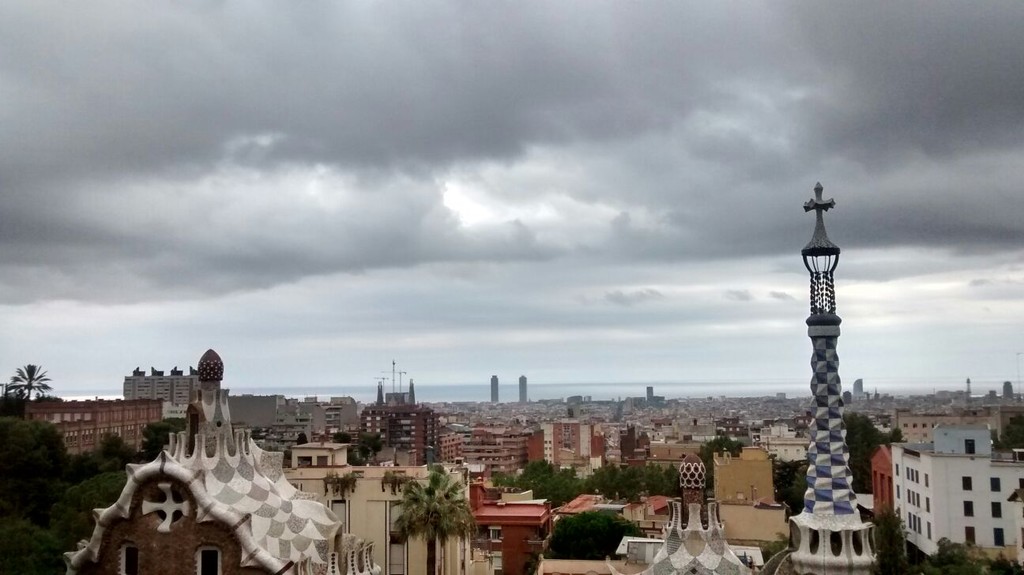
Continuing down the stairs, located underneath the Central Plaza, you'll come across the Sala Hipóstila or the Room of 100 Columns which began being built one year after its upstairs neighbour. It consists of 86 columns to be exact, which were actually designed as extra support for the Central Plaza. It's a very interesting design, and as you can see from the photo, the roof is devised of little domes that go all across the ceiling.

The Sala Hipóstila was thought to be a place for the residents to come together to trade goods and use as a market. Today however, the room makes for an interesting place for tourists to enjoy and due to its great acoustics, it's also occasionally used by musicians.
To the right of the central plaza lies the Pórtico de la Lavandera, an outdoor tunnel that leads to the House of Larrad, an old country house that was converted into a school in 1931. This portico, resembling a big wave, is a great example of how Gaudí looked for inspiration in natural forms.
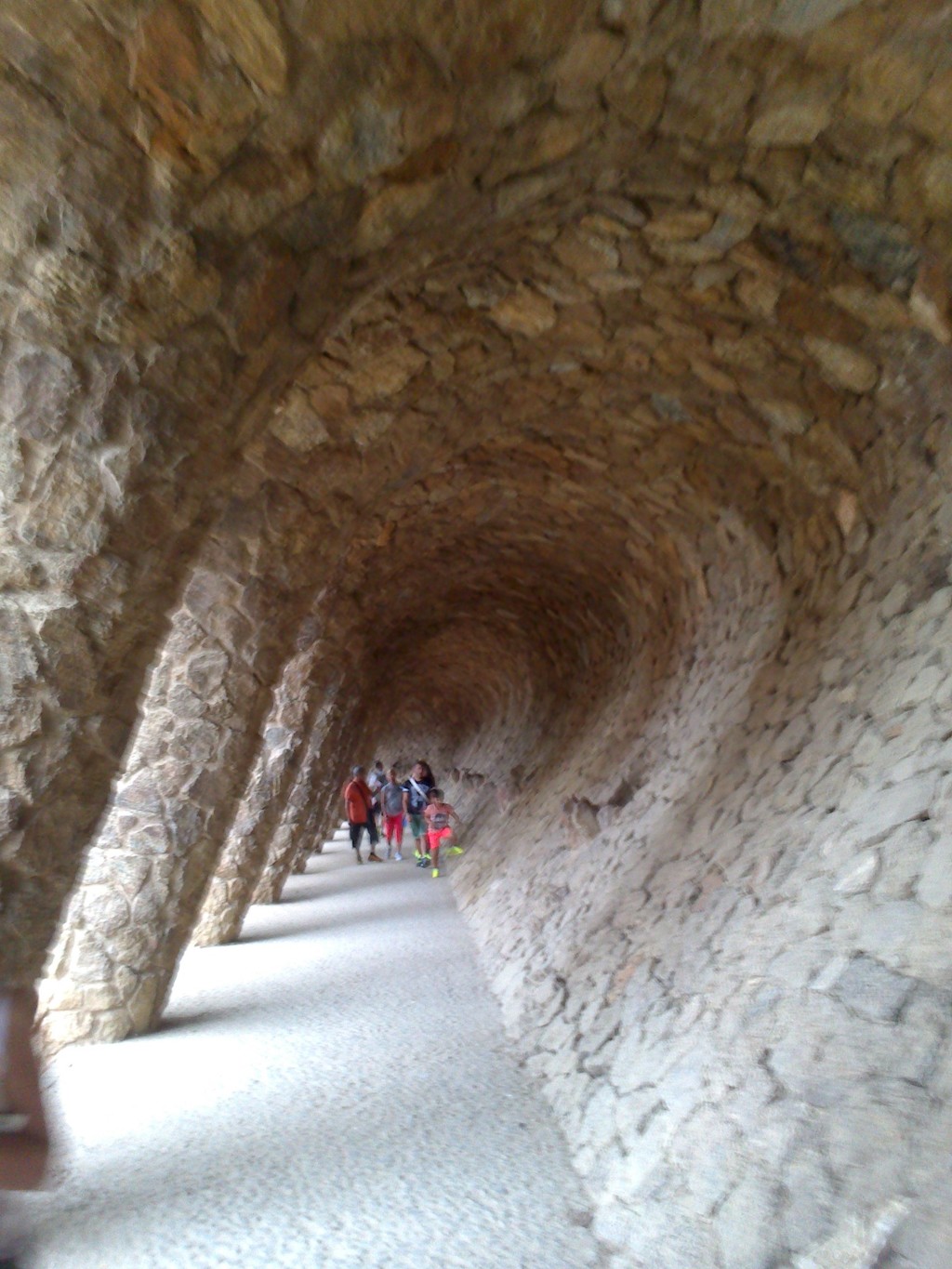
Outside of this you'll see lots of monuments consisting of a series of viaducts, paths and roads which were built wide enough to allow traffic, such as a horse and carriage, to pass through the park. Guadí decorated them so that they would blend in with the natural theme of the park- as you can see, the columns are made to look like tree trunks.
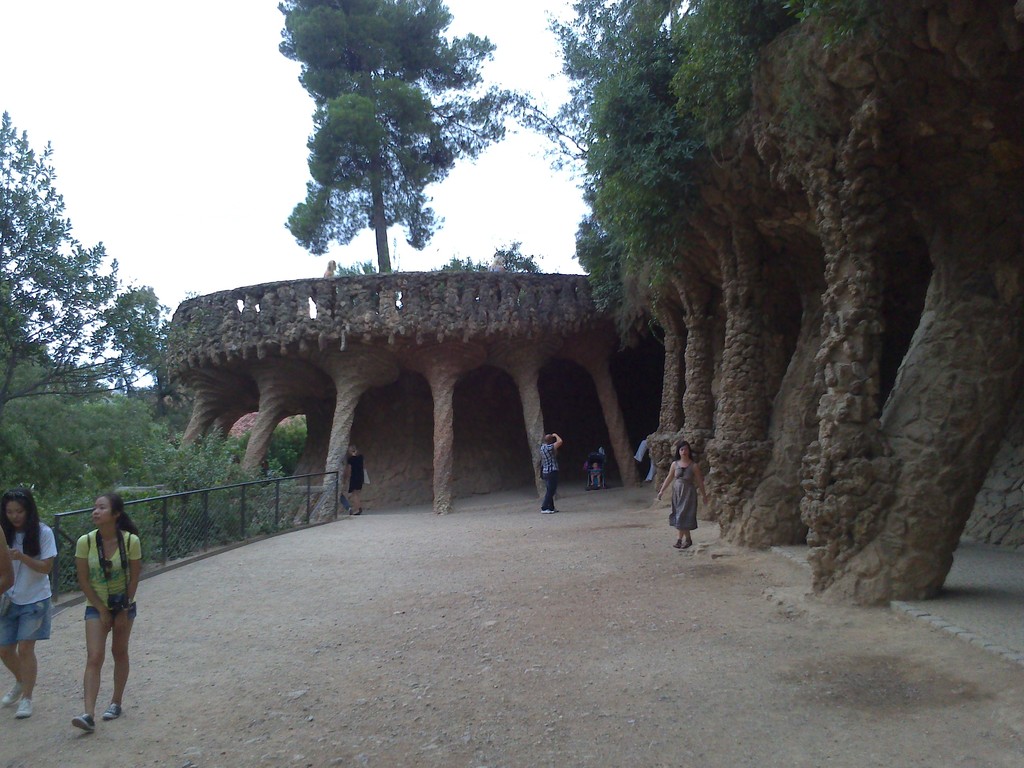
In the park you can also visit the Guadí Museum which used to be the house where he lived with his father and niece from 1906 to 1925. The residence was built as a model for the rest of the houses that would make up the urbanisation, but it wasn't until later that Guadí bought it as he'd realised that the complex would be a failure. Nowadays, it's a museum. Unfortunately that's pretty much all I can say on the matter as I didn't manage to go inside.
All of the central region is surrounded by large green space which are definitely well worth visiting. We'd walked round the different paths until it began to rain and we had to stop the tour! Nevertheless, it gave us time to go up to one of the highest points, a place called the Calvario, which according to Gaudí's plans was originally designed to be a chapel, but like the rest of Gaudí's plans, also failed. From this point you can see three crosses that Guadí built which represent The Passion of Jesus Christ in his crucifixion. The tallest cross is almost 5 foot 6 and the other two are smaller at just over 4 foot 9. The crosses were destroyed during the Civil War in 1936, and were later completely rebuilt by 1939.
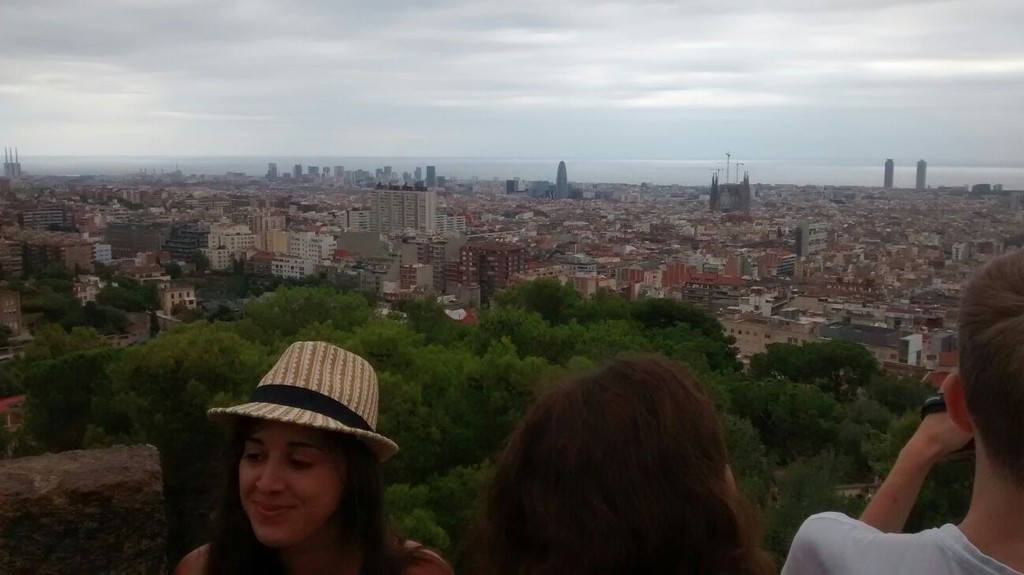
Entrances
As I've already mentioned, from 2013 you have to pay to get in to Park Güell and you can't access it via the huge entrance anymore, so be prepared to climb the stairs to get up to the ticket office before you've even got into the park!
Buying tickets totally depends on how many people want to go in at the same time as you as they only let 400 people into the paid part at a time. Because of this, they recommend that you buy your tickets in advance so you don't lose out on the chance to go into the park. From the moment you buy your tickets you have half an hour to enter the Monument Precinct, so for example if I bought my ticket at 9:00, I have until 9:30 to enter the private part of the park. You can have as much time as you want to explore once you're inside.
Opening Times
- Low season: January 1st to March 26nd: 08:30am to 6:15pm (last entry time at 5:30pm)
- Mid season: March 27th to April 30th: 8am to 8pm (last entry time at 7:30pm)
- High season: May 1st to August 28th: 8am to 9:30pm (last entry time at 9pm)
- 2nd Mid season: August 29th to October 29th: 8am to 8pm (last entry time at 7:30pm)
Cost
- General entry bought online: 7€
- General entry bought at ticket office: 8€
For more information on pricing and discounts click here.
What most people don't know is that if you get there before the opening times, you're allowed in for free.
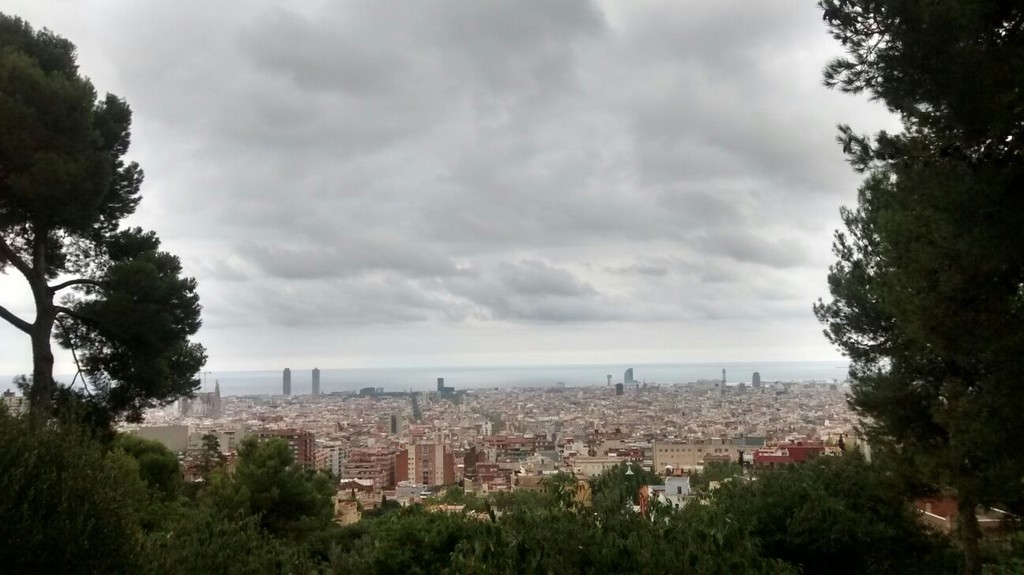
How to get there
Park Güell is situated just off of Carrer d'Olot.
You can use the metro which is perhaps your best shot; you'll need the green line (line 3) and you can get off at either Vallcarca or Lesseps. Both are a 15 minute walk and also have escalators. There are signposts everywhere so you shouldn't get lost- but just in case, carrying a map round with you wouldn't be a bad idea!
You can also take the bus; lines 32, 24, and 92 all go by, or if you want to really play it safe I bet the tourist buses go by!
I hope you enjoyed reading this and that it may have been of some help for your future planning!

Photo gallery
Content available in other languages
- Español: Park Güell
- Italiano: Park Güell
To Spend the Afternoon
Parc Güell is a park designed by Antoni Gaudi, a well-known architect in Barcelona famous for having designed other buildings such as the Sagrada Família and the Casa Batlló...
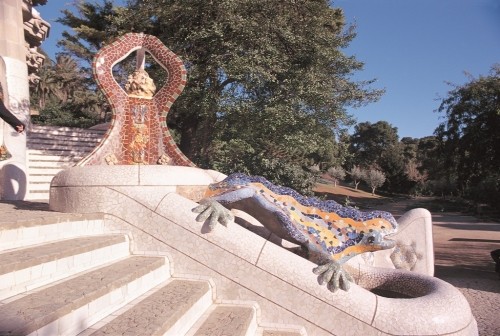
Parc Güell is inspired by nature and animals, it is very pretty, there is a good ambiance and it is a good place to go and spend an afternoon. Entrance costs €7, but it's really worth the cost! If you are in Barcelona you must go and see it, it is very big and different than the rest of Gaudi's works, hence Gaudi's style is unique!
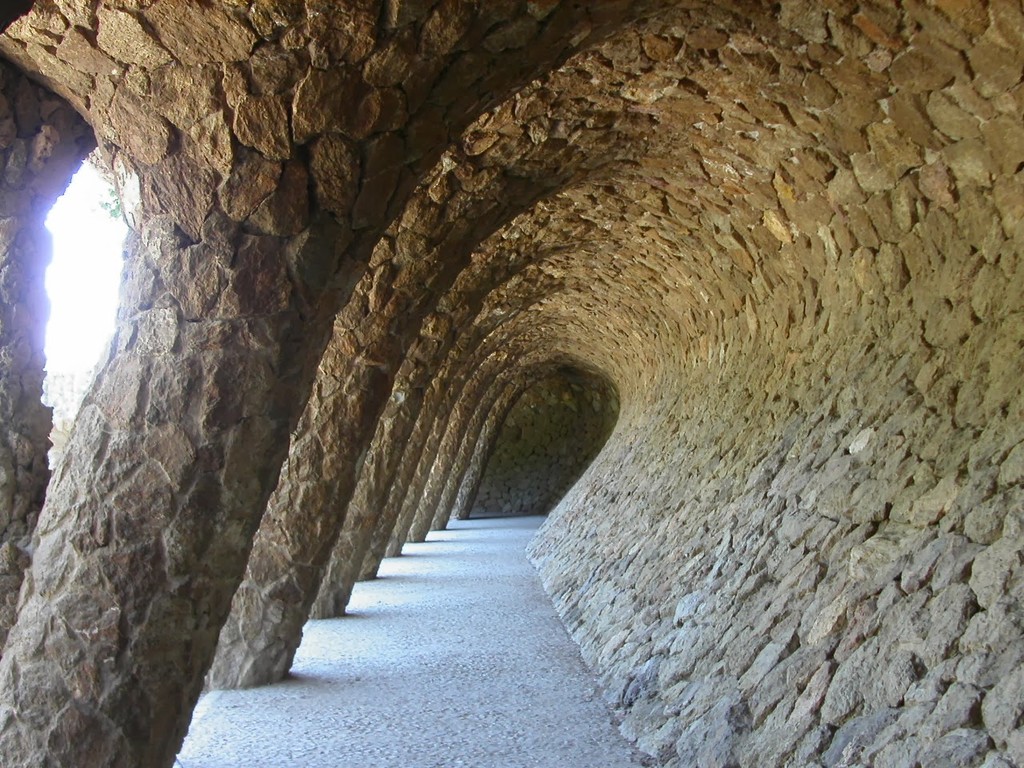
Photo gallery
Content available in other languages
- Español: Para pasar la tarde
- Deutsch: Den Nachmittag verbringen
- Français: Pour y passer l'après-midi
- Italiano: Per passare un bel pomeriggio
- Polski: Pomysł na spędzenie wieczoru
So much to see at Parc Güell
Barcelona's magnificent Parc Güell is perched atop a hill, it was created at the beginning of the twentieth century by architect Antonio Gaudi, and it's absolutely remarkable. Gaudi managed to create a garden where nature is the main attraction thanks to all the greenery in the area. Once we pas through the entryway, two gingerbread-style houses emerge and surround us. One of them is the souvenir shop, and as in all tourist traps, prices are quite high. The second is Gaudi's house, but be prepared to wait around 45 minutes to visit it. This, for two reasons: The lack of size of the space making it so crowds could not make it in, and since there is such an overwhelming number of tourists it's difficult to make it in right away. Basically we did not have the patience to wait that long.

Beyond the two houses are the large white steps. In the centre of the steps we can find two foutains, the emblematic salamander and the other in the form of a serpent.
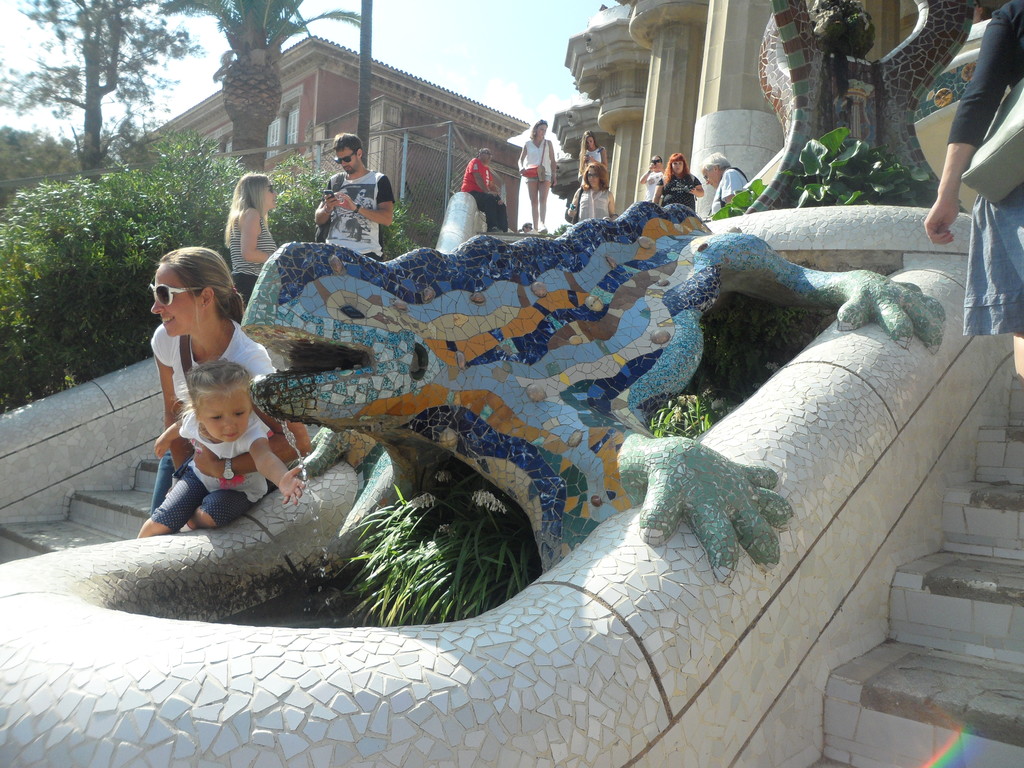
Once at the top of the steps, you ca find the « Sala Hipolista », which welcomes us with its 86 columns which support the upper platform. The slight inclination of the columns toward the windy exterior of the ledge passing above plays a fundamental role in the design of the main entrance of the park.
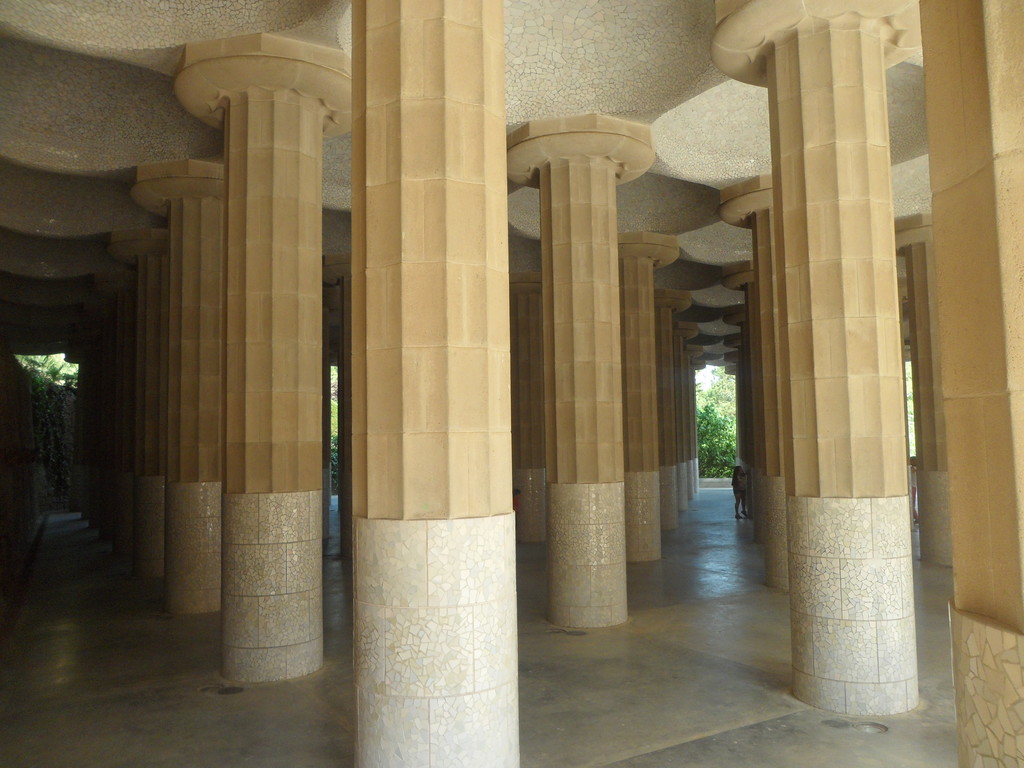
Surrounding the main entrance there are more flower gardens for us to admire, and once we climb the next flight of stairs we can finally appreciate the curvy mosaic benches and their columns, where even the pigeons are enjoying themselves.
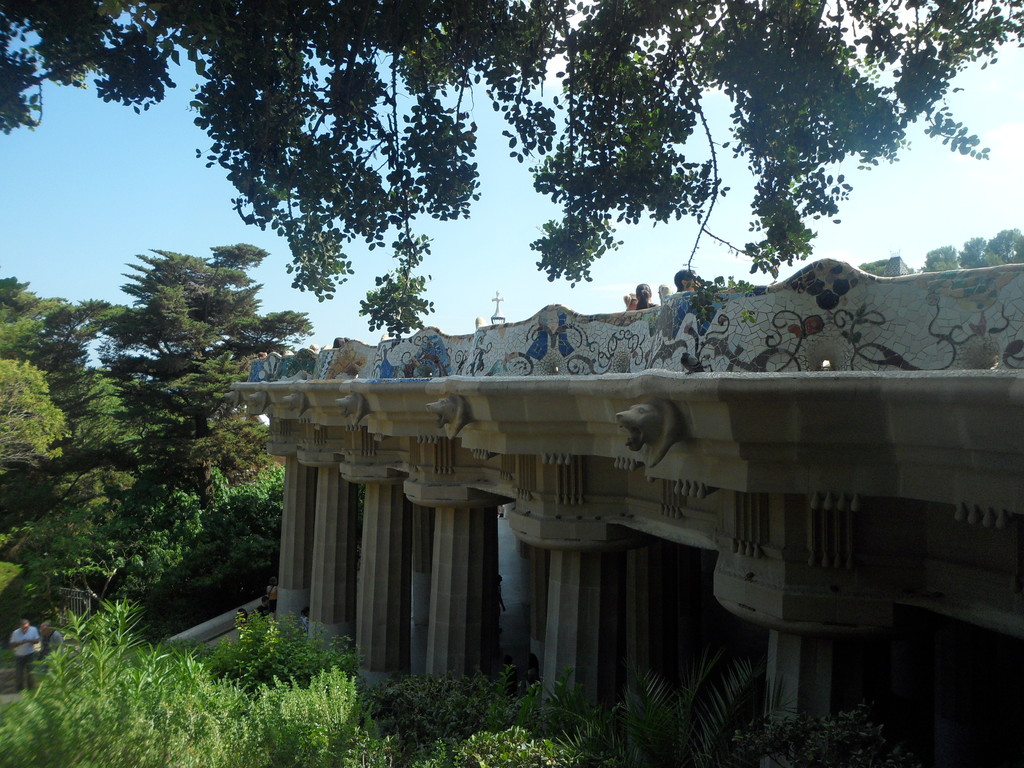
Finally arrives the long-awaited moment, reaching the most well-known area of Parc Güell: the magnificent coloured bench surrounding the entire platform with an amazing, unobstructed view over Barcelona and Gaudi's houses. The photos and selfies here are aplenty among the tourists wishing to mark their presence at this famous spot. For all fans of the film L'auberge Espagnol, this spot is mythical, and following the footsteps of Romain Duris had always been a dream for me, a dream finally realized!
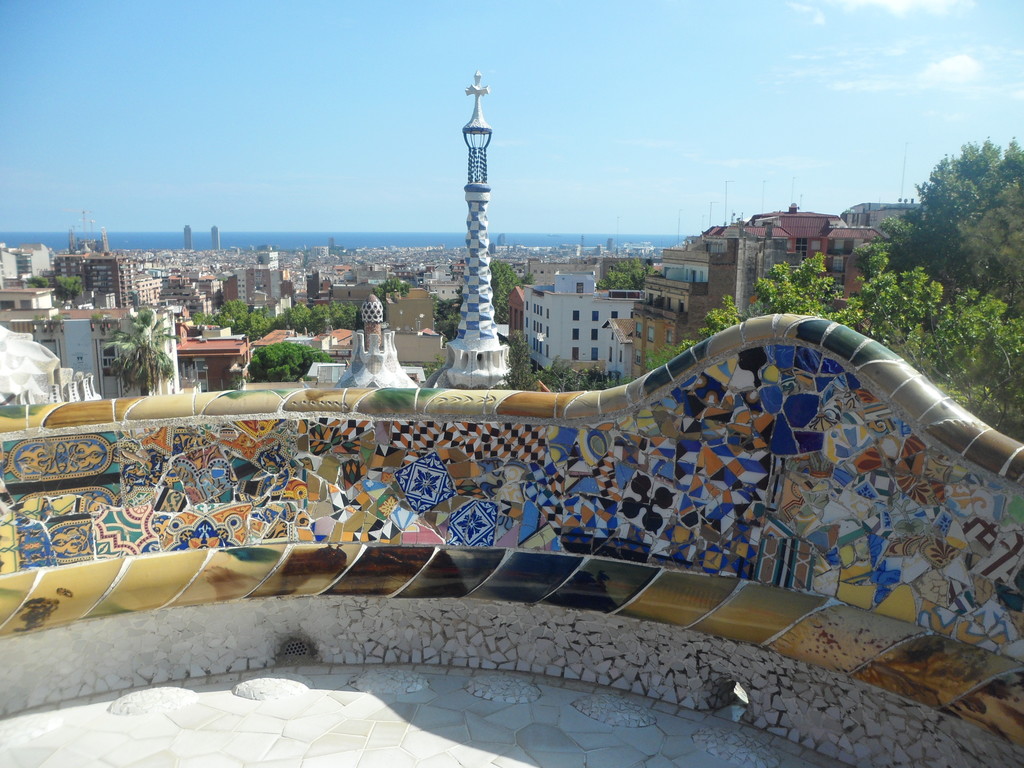
The aforementioned section of the park is not free to access, entering it costs a total of 8 euros, though it is largely worth the price, especially since the tour can be completed in a mere half hour.
The remainder of the park is free to access and is dedicated to a decor of greenery and dotted with fabulous walking paths, though some people prefer running. Sure, it's a dream spot to do some 'running, ' but it can't be very practical to need to zigzag between all the tourists. Unfortunately, with all the tourists, the Pakistanis take advantage to sell their many souvenirs and others play some traditional Spanish music or the saxophone, which is a lot more pleasant.

The park is accessible via several means: for the most courageous and those ready to confront the climb, it is about a 30-minute walk away from the Sant Pau hospital. Otherwise, the Carmell-bound bus 24 brings you straight there from the Plaza de Catalunya.
Photo gallery
Content available in other languages
- Français: Pleins les yeux au Parc Güell
- Español: Parque Güell
- Italiano: Il fantastico Parc Güell
Park Güell and Bunkers
Hello again lovely people!
Today I'm going to write more about Barcelona. As you've already seen for sure in the title, I'm going to be speaking about the famous Park Güell, which is a must-see if you're visiting my wonderful Barcelona, and the bunkers. They are both situated in the upper part of Barcelona, in the Carmelo neighbourhood (the neighbourhood of the same name of the nearest metro stop, along the blue line).
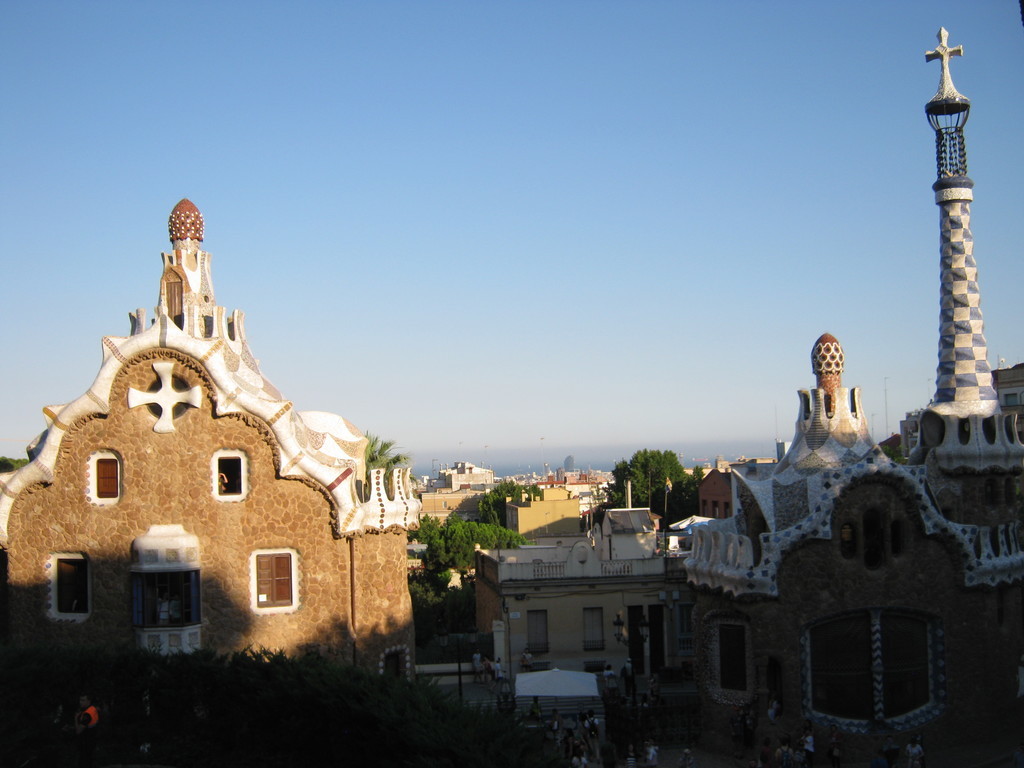
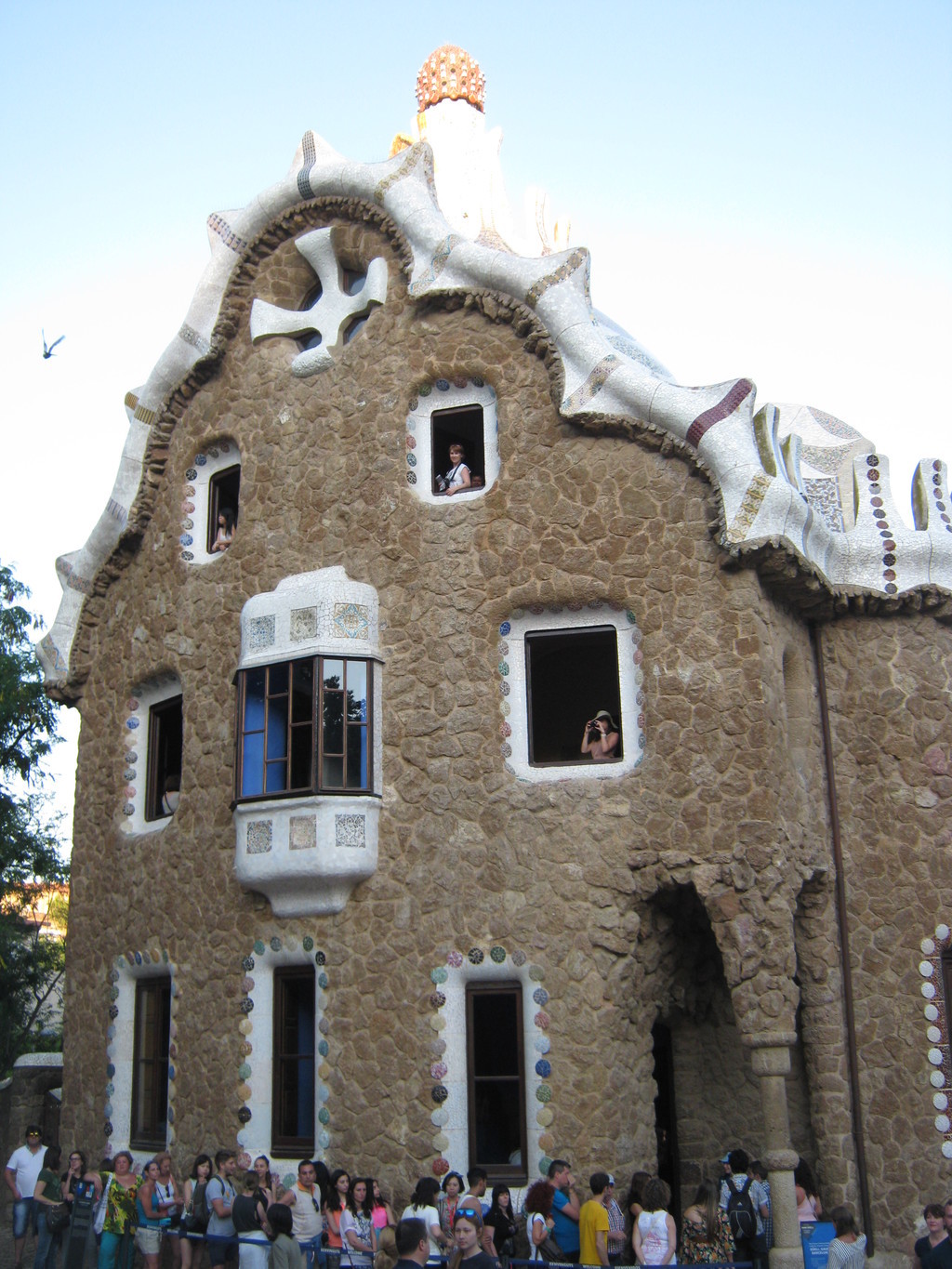
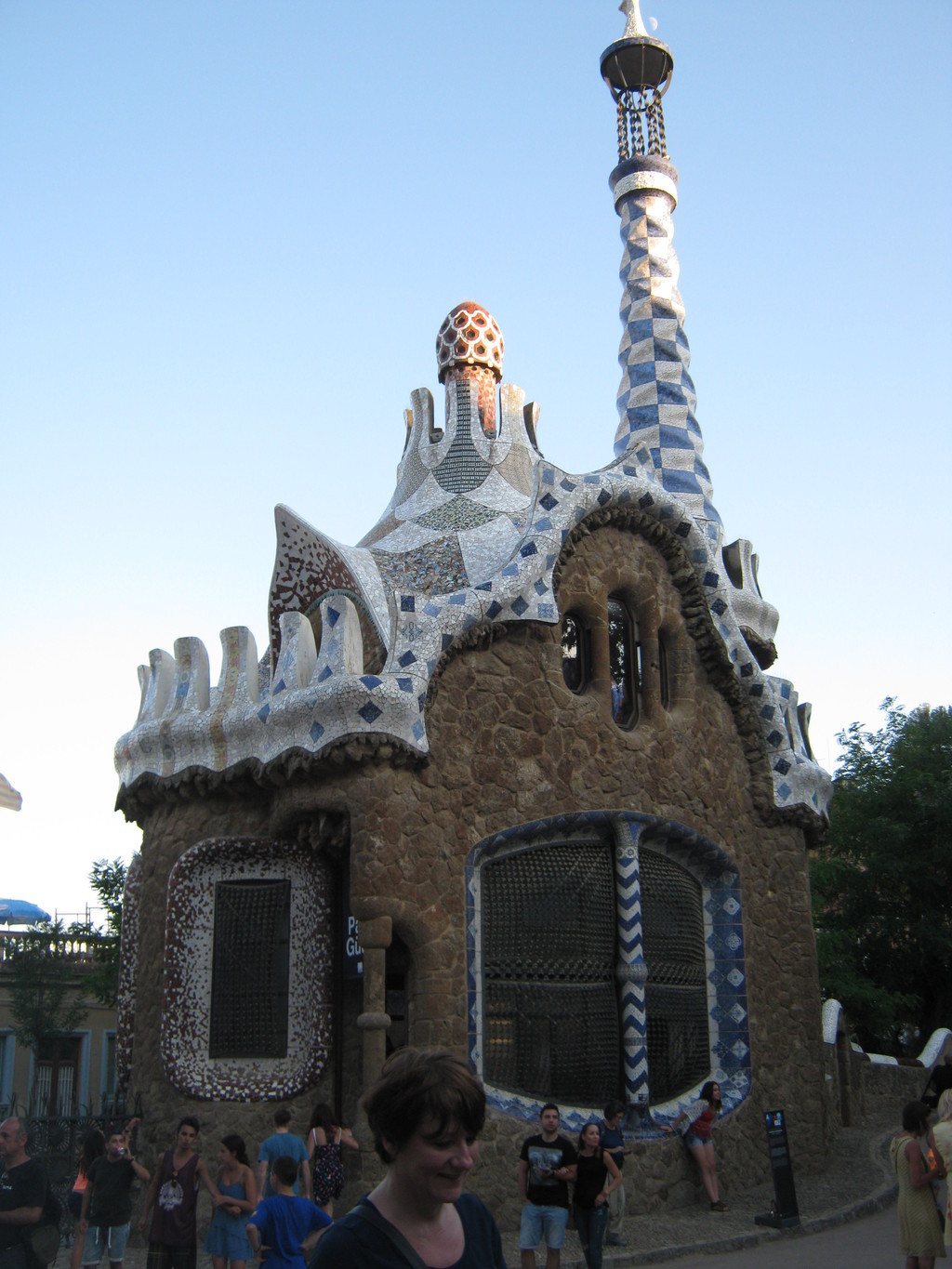
We'll start with Güell park! This enormous park was one of Guadí's first creations for the city of Barcelona, and it really is spectacular. In order to visit the park, you have two options; one is paid and the other is free entry. The free entry doesn't allow you to go to the park's most famous area, which is really where the great artist's work can be seen. Having said that, if you prefer not to pay, you can see and appreciate his art from afar.
The paid option is only 8 euros I believe, and gives you access to all parts of the park. Truthfully, I recommend this hugely. It's absolutely beautiful and his colours and creations are fantastic. Also, if you buy the tickets online, it's cheaper and saves you having to queue and wait. And of course, if you choose this option, you have to decide on a concrete date and day to go. I'll leave a link to the website here where you can view this information and many more interesting things about the park: Park Güell website.

Being in the upper area of Barcelona, the views seen from here over the whole of Barcelona are mind-boggling. Possibly the best you can get!
The other thing which I would like to speak to you about in this post, are the 'Bunkers'. Situated 15 minutes away by foot from Güell park, are the old Bunkers of Barcelona, from where there are spectacular views over all of Barcelona. Park Güell is always crowded with people because it is possibly the most touristy place in the city, it may not be so nice or relaxing to enjoy the skyline of Barcelona from there. So I'm suggesting the idea of going to the bunkers, where you can sit, lie down or whatever you want, while listening to music and chatting with your friends, and see Barcelona from the above.
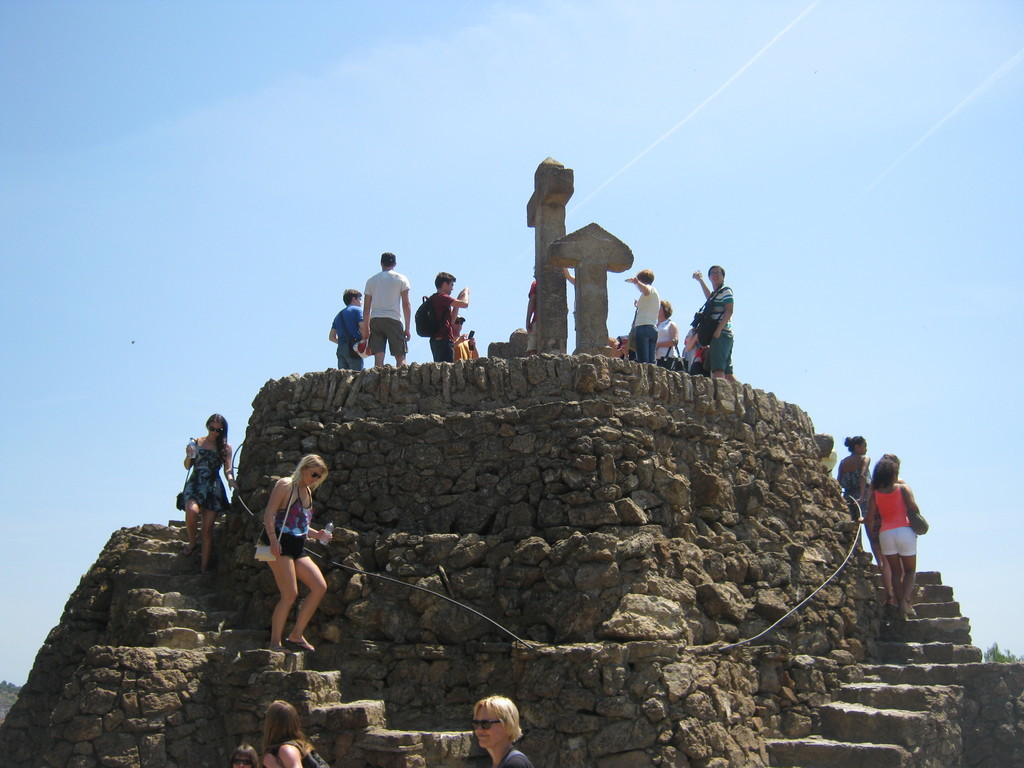
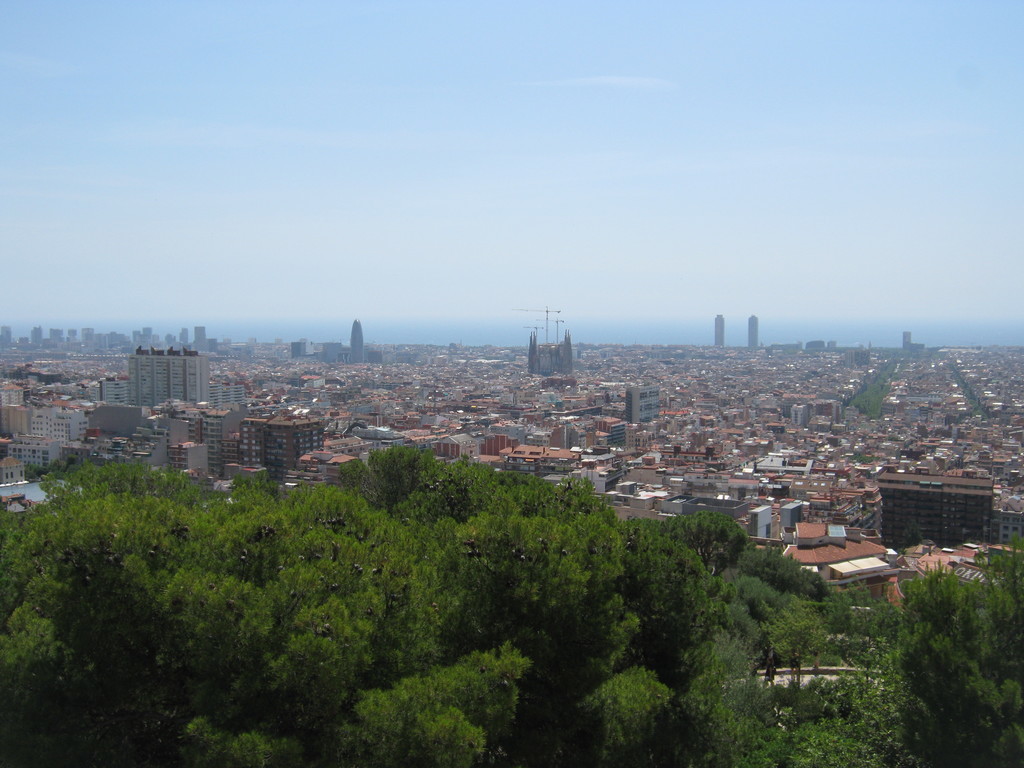
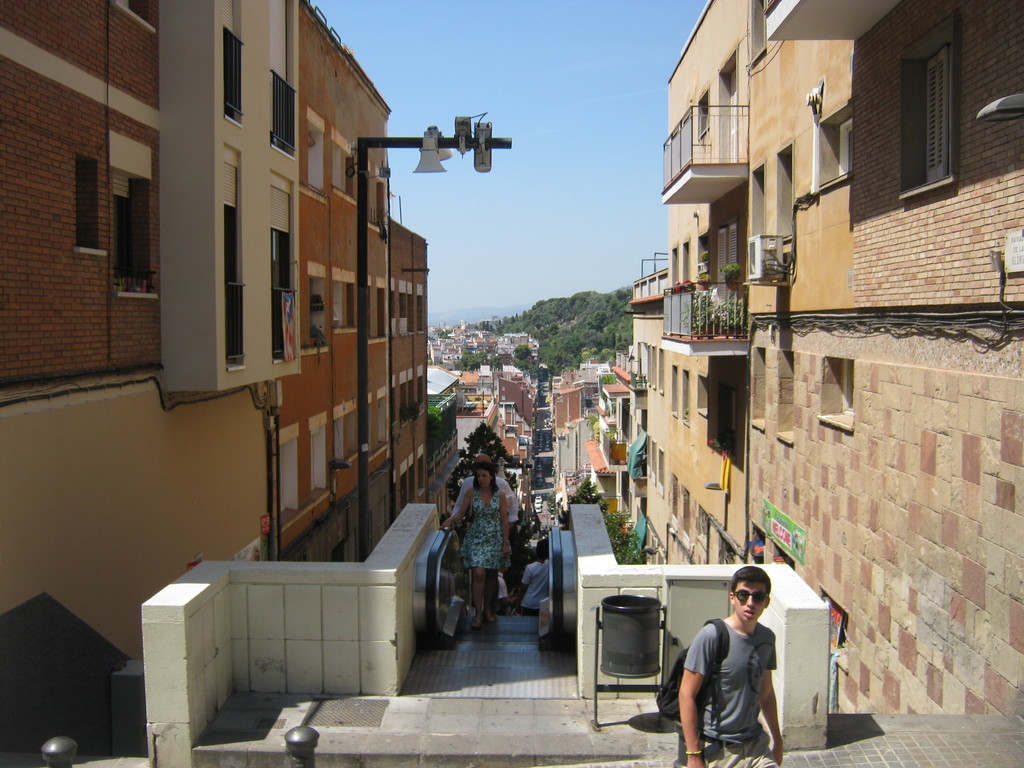
Last term, ESN volunteers organised a trip to here, I haven't seen this activity scheduled for this term, so I hope I have given a great idea and a nice visit to do!
Enjoy and speak soon! Bye-bye.
Photo gallery
Content available in other languages
- Español: Parque Güell + Búnquers
- Français: Parc Güell et Bunkers del Carmel
What a beautiful appearance it has
Hello Ana!
I remember when I studied History of Art as an undergraduate and became absolutely infatuated with the work of Gaudi. And rightly so! Just look at this fantastic park! I only knew about its artistic history and historical facts, but now thanks to you, I have gotten to know its true beauty. I can not believe that there is something as beautiful as this so close to me, and yet still, I haven't made time to see it.
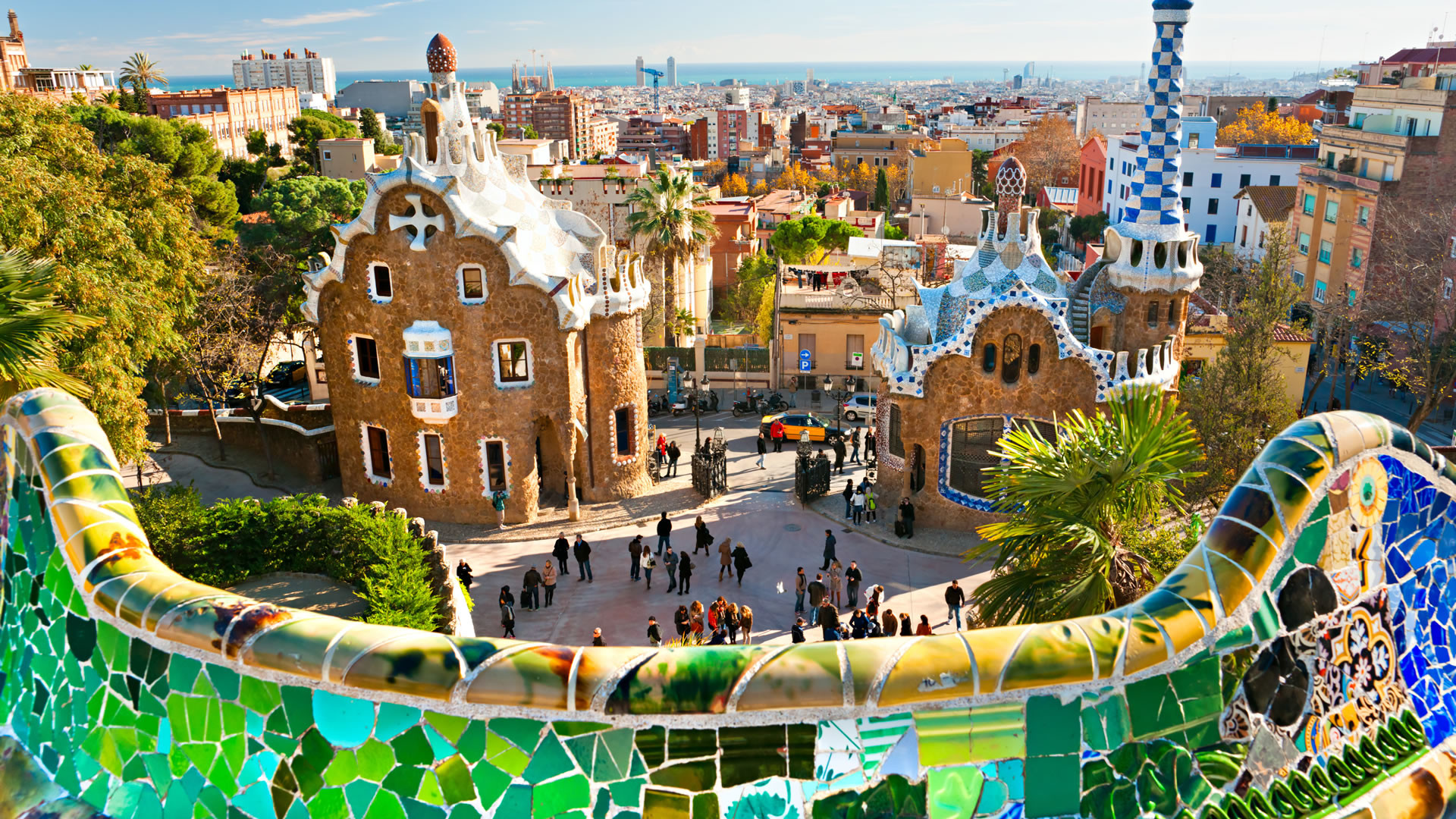
Thank you so much for your comment about the park. If you have anything else to share I would appreciate you commenting it here as well because soon I would like to visit Barcelona and I don't want to miss not even one detail in regards to the beauty of this great city!
I was thinking about going during the Christmas season. Is that a good time to go? Or do you recommend that I go during a better time? I still have time to change my plan! :P
Once again, thank you very much! I will see if you have anything else written about Barcelona so that I can get an idea of all the incredible things that I must see while I'm there!
A big thank you.
Photo gallery
Content available in other languages
- Español: Qué buena pinta tiene
- Deutsch: Wie gut er aussieht
Rate and comment about this place!
Do you know Parc Güell? Share your opinion about this place.













































































































